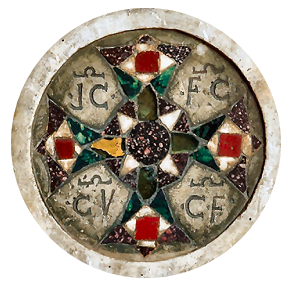| Devotional
confraternities of laymen were common in late medieval Italy and elsewhere
called a confraternita and compagnia. Scuola was
the term applied in Venice, meaning 'school' and deriving from the Latin
word 'scola' meaning corporation, and applied to various religious,
charitable and professional organisations. They were placed under the secular
jurisdiction of the Venetian government, so their religious devotion had
something of a civic
character, and so they were seen as agents of social cohesion rather than
potential discord. Membership was broad-based and usually included women
and ranged from wealthy cittadini to humble artisans. Artist
members included Giovanni Bellini who belonged to the Scuola di San Cristoforo, Pietro Lombardo to the Scuola di San Girolamo, and Palma
Vecchio to the Scuola di San Pietro Martire. Only members of Venice's
hereditary patriciate and the clergy were
excluded from full membership of the scuole, yet they often associated in
an honorary capacity. Only vagrants, beggars, prostitutes, and other
social outcasts were totally excluded.
In
1467, the scuole in Venice were officially organised by merging the
artisan and common scuole into the Scuole Piccole (Small Schools)
and the Scuole Grandi (Great Schools). The latter were created from the
previously-named Scuole dei Battuti (of the Beaten)
who saw ritual self-flagellation as an act of penitence for the redemption
of the individual and the community. This tendency in northern Italy had
sprung from the late-13th century mood of doom and repentance, following
years of famine, plague and civil strife, and is said to have been
originated by a Perugian hermit in 1260. As the desire for expiation waned
this flaying became more ritual in nature, but poorer scuola
members could be paid to undertake the punishment, or forced with the
threat of withdrawal of charitable payouts. There were also scuole for Venice's
citizens from elsewhere, like Greece, Germany, Dalmatia (the Schiavoni),
Florence and Bergamo. At the funeral of Cardinal Zen in 1501, Marin Sanudo
counted 210 confraternity banners.
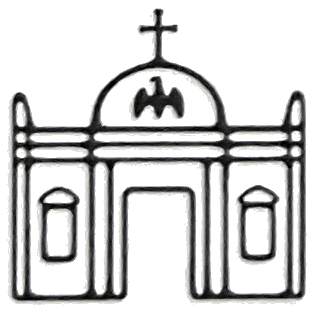
The Scuole Grande all had their own buildings,
built in the 15th and 16th centuries, the Scuole Piccolo tended not to,
and to meet in a particular church.
The earliest-founded scuola grande were Santa Maria dell Carità and San
Marco in 1260, then San Giovanni Evangelista in 1261 and Santa Maria della
Misericordia in 1308. These were the original four, to which were added the
Scuola di San Rocco in 1478 and in 1552 the Scuola di San Teodoro. Then in
1767, only thirty years before the fall of the Republic of Venice,
the Scuola dei Carmini, which had been founded in 1593, was added to the list. There
were, briefly, nine, and 925 scuole piccole.
|
|
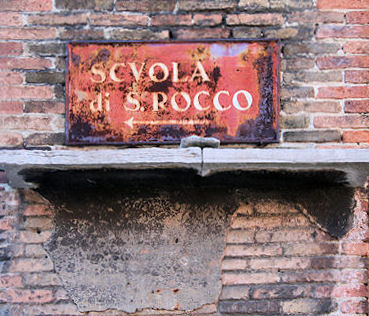
Membership of the Scuole Grandi was limited, the
Scuola di San Marco was allowed 600 members and the others 550. The
government of the scuole involved four major officials - the leader (guardian
grande), his assistant (vicario), a record keeper (scrivano),
and a master of the novices (guardian da matin). Two further
deacons (degani) assisted with keeping contact with the brothers,
who could be scattered all around Venice's sestieri. The officers met
regularly in committee (banca) and by the early 15th century all
officers had, by law, to be native-born citizens of Venice.
Like many other religious institutions the scuole were suppressed by
Napoleon in 1806, with only San Rocco and the Carmini allowed to keep
their art. But later in the 19th century some were
re-established, including the Scuola San Giovanni Evangelista.
This is a new page on
this site and hence doesn't have the benefit of the years of honing that
the others have had. More obscure scuole will no doubt be added,
sites visited, books read and entries improved, as the years pass, leaves
fall from trees and calendar pages fall, etc. |
|
The Scuole Grande
Carità
Santa Maria della Carità
Carmini
Misericordia
Santa Maria della Misericordia
San Giovanni Evangelista
San Marco
San Rocco
San Teodoro

The Scuole Piccole
Albanesi
Calegheri
Laneri
Mercanti
San Giorgio degli Schiavoni
San Fantin
Santissimo Crocifisso
Varoteri

|
|
Carità |
History
In 1260 the
Scuola di Santa Maria della Carità, the first Scuola Grande, was founded in
the church of
San Leonardo. The scuola then rented rooms from, and near,
the monastery of Santa Maria della Carita, and later bought land and
buildings from the monastery. By 1343 it had two meeting rooms, one above
the other, and this may have been the original model for later scuole
buildings - comprising of an upper meeting room (sala) and a lower
meeting room (androne). In the mid 15th century an extension was
added here as an albergo for the meeting of the banca. This
building's façade can be seen in the background of Canaletto’s
Stonemason’s Yard.
Titian was later commissioned to paint a
Presentation of the Virgin on one wall of the Sala
dell’Albergo. From this room the banca distributed alms and choose young
women to receive dowry contributions. The only major additions after 1560 were
in 1766 when Giorgio Massari rebuilt the entrance hall and changed the façade, and Bernardino Macaruzzi designed the curved double staircase
up to the sala capitolare.
In the early 19th century the scuola and
the adjacent church and convent buildings were transformed into the
Galleria dell’Accademia.
The Accademia, initially just an art school, had been housed at the
Fonteghetto della Farina at San Marco. Needing larger premises they had
proposed the convent at San Zanipolo, with the adjacent Scuola Grande di
San Marco, the Misericordia complex, or the Santa Caterina complex. But
what they got was the Carità.
Work began in 1811, headed by Giannantonio Selva, and the gallery opened
in 1817. Since
then the collection has grown and the layout and decoration of the rooms
has been adjusted in ways large and small, most notably, during the 1940s
and after, by Carlo Scarpa, and in 2021 with the opening of bright new
LED-lit rooms on the ground floor (see photo right).
The façade
You enter the gallery through what was the scuola entrance. The old postcard (see
above right) shows the buildings
before the coming of the vaporetto stop, and also shows the original iron
bridge. The carved panel over the main
doorway (The Coronation of the Virgin by Bon) and the statue group
on the roof (Minerva Seated on the Adriatic Lion by Antonio
Giaccarelli) are both long gone. The latter statue was a compromise
reached to end the disagreement between the Accademia and the government
as to whether to top the facade with a statue of Minerva or of a lion. The panel is now
in the Salute and the statue is to be found in the
Giardini Pubblici. Jan Morris says of the latter "the silliest
lion [in Venice] stands in the Public Gardens, removed there from the
façade of the Accademia: Minerva is riding this footling beast
side-saddle, and on her helmet is perched another anatomical curiosity -
an owl with knees".
The façade between the church and scuola is an
entrance to the scuola and features three once-polychromed statues.
They are by Marco Zuliani and show The Virgin and Child with
Worshippers, from 1345, and flanking the door are Saints
Christopher and Leonard from 1378.
Interior (The Accademia Gallery)
The gallery contains many works
from the suppressed and demolished churches mentioned elsewhere on this
website. The first room at
the top of the late-18th-century staircase as you enter the galleries is the former
sala capitolare (chapter
house) completed in 1343. It has a gilded ceiling of 1461-84 by Marco Cozzi, a member of the
confraternity. It is one of the
two rooms where the scuola building's original features can be seen.
However the five high-relief plaques originally set into the ceiling,
depicting the Madonna della Misericordia and the symbols of
the other Scuole Grandi, were removed and dispersed in 1814. Now there is
a God the Father attributed to Pier Maria Pennacchi from the
oratory of San Girolamo in Venice, and four Prophets by Domenico
Campagnola from the Scuola della Madonna in Padua.
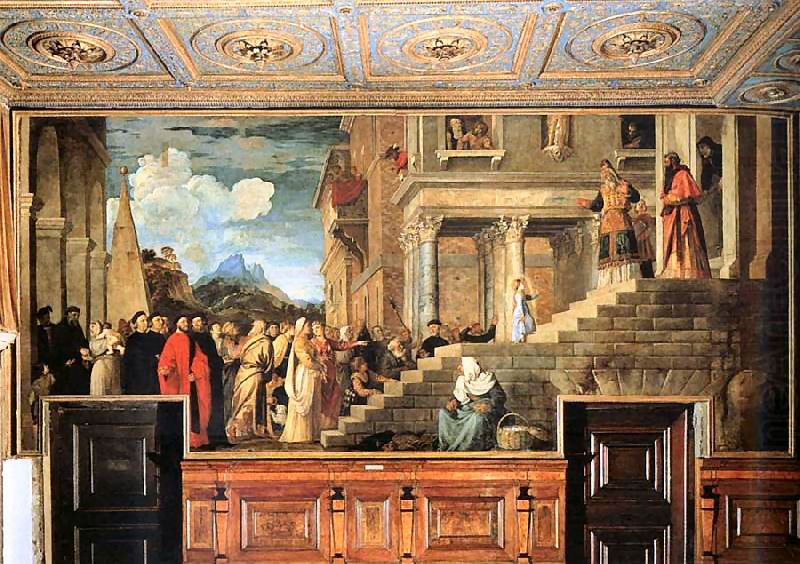
The
other remaining original room is the sala dell'albergo, built in
1384 and enlarged in 1422/24, which is adjacent to the
sala capitolare, but comes at
the end of the gallery circuit. It also retains its gilded polychrome
ceiling with a God the Father in the centre, probably from the
ceiling of the
sala capitolare and
moved here following a fire which destroyed the ceiling there in the late
15th century.
The sala dell'albergo also
has surviving panelling and benches, along with
Titian's very architectural Presentation of the Virgin (see above) in its
original position.
The gallery also incorporates the Nuova Cancelleria
(New Chancellery) of the scuola which was decorated between 1768 and 1763
with scenes from stories from the Old Testament by the likes of
Giandomenico Tiepolo, Jacopo Guerana and Jacopo Marieschi.
Lost art
Jacobello del Fiore painted large frescos of
apostles for this scuola in 1418.
The scuola had a Giovanni Bellini
Virgin and Child with Red Cherubim, now in the
Accademia.
As is an ornate triptych of The Virgin and Child Enthroned Between the
Fathers of the Church (see right) which Antonio Vivarini and Giovanni d'Alemagna painted
on canvas and signed in 1446 for the sala
dell'albergo here, where it sat on an altar opposite Titian's
Presentation. The original frame was destroyed at the same time as the
altar in 1811, when Selva installed the short flight of stairs up to a new
door. The canopy over the Virgin features the scuola's insignia and the
word caritas is worked into the painted frieze.
The Finding of Jesus in the Temple by
Gianantonio Fumiani and a Circumcision by Gregorio Lazzarini, both
from c.1700 and both huge, are both in the Accademia, in one of the new
ground-floor rooms, 5 and 6, opened in 2021, dedicated to religious art of
the 17th and 18th centuries. They were part of a series of scenes from the
life of the Virgin and the childhood of Christ painted for the Sal del
Capitolo here, which is now Room One of the Gallery, also involving
Sebastiano Ricci. Two more painted by Lazzarini are now lost.
There's a Three Angels Appearing to Abraham
by Giandomenico Tiepolo from 1773 in the Accademia from the series
mentioned above for
the Nuova Cancelleria (New Chancellery)
post-rebuilding, for which this was the last commissioned. The buff and
imposing trio of angels that dominate the painting are a far cry from the
homely dinner guests traditional to the scene. Along with The Death of Rachel by Giambettino Cignaroli
from Verona of 1769/70 it is now also to be found in in one of the
bright new ground-floor rooms opened in 2021. This same Old Testament
program also included Elias and the Angel by Lorenzo Gramiccia, Moses Rescued from the
River by Giustino Menescardi and, on the ceiling, Divine Wisdom
and The Theological Virtues by Jacopo Marieschi.
On the side wall of the
sala
dell'albergo were
The Marriage of the Virgin by Giampietro Silvio and The
Annunciation by Girolamo Dente, now in the parish church of Mason
Vicentino.
The scuola in art
Aside from the Canaletto mentioned above the
original entrance façade
is also visible in the 1584 Doge
Sebastiano Ziani's Recognition of Pope Alexander III at the Monastery of
the Carità by Carlo and Gabriele Caliari, the son's of Paolo Veronese
(see right). It's in the Sala del Maggiore Consiglio in the Doge's
Palace.
There's a watercolour in the Ashmolean by Turner from 1840 called The
Accademia from the Grand Canal.
Opening times
Monday
8.15-2.00
Tuesday-Sunday 8.15-7.15
Vaporetto
Accademia
map
|
|
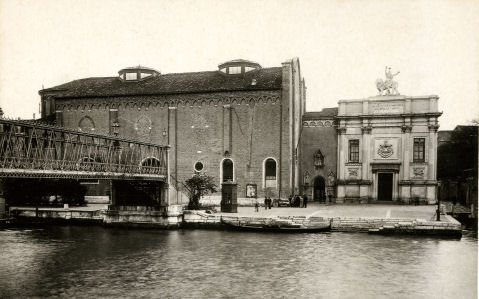

Art highlight
A competition to paint The Presentation of the Virgin, as part of a
sequence devoted to the Life of the Virgin
for the salla dell'albergo,
had been won in 1504 by Pasqualino Veneto, a minor artist, who had died soon after. It took the
board of the Scuola another 30 years to finally commission Titian,
on 29th August 1534, who finished his painting before March 6th 1538. His main challenges were the size and having to
incorporate a door. The composition (see left) is traditional, rather than
innovative, and this may be down to the commissioners, who may have even
insisted on retaining Pasqualino's original composition. The obelisk, a
frequent feature of Presentations, is traditionally symbolic of the sun,
and by association Christ as the light of the world. The painting is lit
from the left, reflecting the presence of a window to the left which had
been adjusted during painting by the officers for this purpose. Mary's
parents, Joachim and Anna, can be seen in the background leading a
procession of officers of the Scuola. Amongst the portraits identified
amongst the staffage at various times are Bembo, Aretino, Titian (he's the old
woman, he's in the clouds!) and his daughter Lavinia. The hag with her
eggs and chickens is also much discussed in the literature with Panofsky calling her
'the horrid egg woman'. She may represent unconverted Judaism, she is said
to echo similar figures in Cima's Presentation and Carpaccio's
Reception of the English Ambassadors from the Saint Ursula cycle, now in
a room nearby. On March 10th 1572 the scuola cut another door through the painting,
on the left.
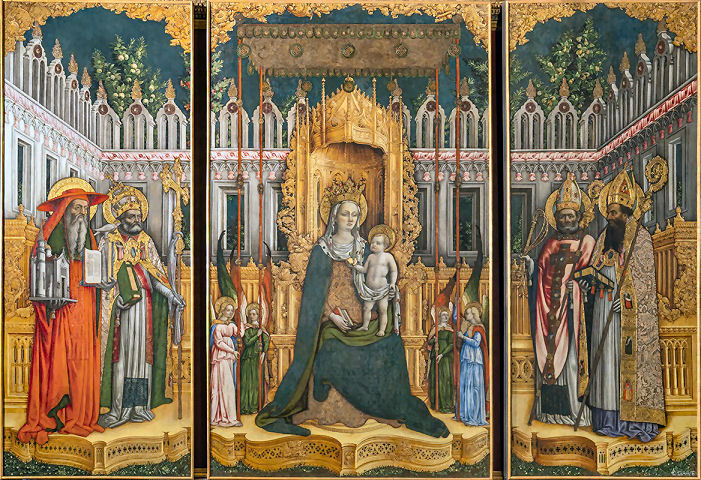
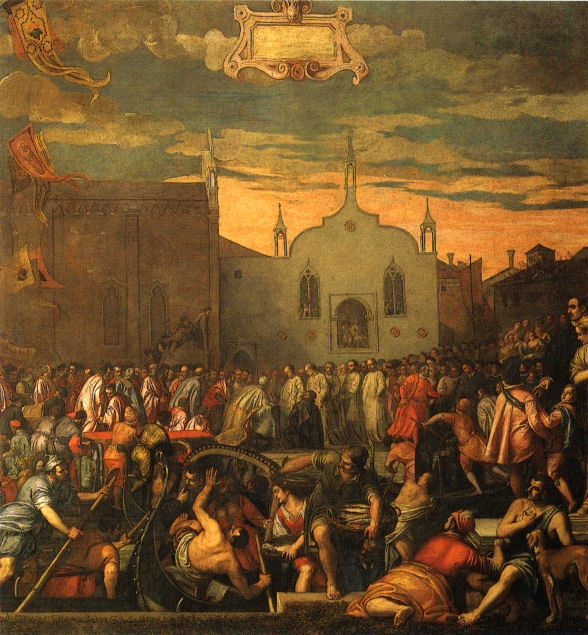
|
|
Carmini |
History
Founded in 1594 under Doge
Pasquale Cicogna, this scuola was the last to be recognized as a Scuola
Grande in 1597. Initially it had used an altar in the church of
Carmini
(the third one on the right) and a room
in the monastery. These rooms changed frequently and were often
found wanting. In 1625 the scuola at last took possession of a site to
build its own premises, but a couple of years of legal wrangling with
remaining tenants and the sellers of the land followed. These continued
even after the scuola building was erected. Designed by Francesco Caustello,
an architect of whom nothing is now known, it wasn't structurally
completed until 1636 and publicly inaugurated in October 1638. Further
purchases of property blocking expansion followed in 1668, and the
demolition of a decrepit pharmacy called Alle Tre Frecce (the
Three Arrows). For the next two years Baldassare Longhena, architect of the
Salute and the Ca' Rezzonico, was employed to expand and embellish in a
Baroque style.Interior
After the little room where your money is taken you pass the
staircase and enter the chapel, which is not a highlight. The monochromes
all around, by Nicolò Bambini and his son Giovanni are rare, but lack
colour.
Up the tunnel-vaulted monumental
staircase typical of a Scuola Grande - double becoming single, but remaining
the same width. It was designed by Longhena and finished after his death by Gaspari. Stucco
sirens progress to golden angels and putti, mermaids and eagles by Alvise
Bossi 1728/9.
On the first floor the fine chapter house (Sala
Capitolare) has nine ceiling panels by Giambattista Tiepolo (from 1739-49), with stucco work by Abbondio Stazio.
Unlike his other Marian ceilings of the time, at the Gesuati and the
Scalzi, Tiepolo worked here in oil paint not fresco. The central canvas was the last to be installed, in 1749,
and depicts Saint Simon Stock receiving the Scapular from the Virgin. A
scapular was originally a cloak, but here it is a loop of cloth which the friar
wears hanging from his neck, bearing a pouch containing a holy image. In
four more panels angels carry scapulars and flowers among the
clouds, and the four corner lunettes represent the virtues. To appreciate the
panels you need to stand in the centre and revolve, and focus on each,
weirdly-shaped panel separately. There are uninteresting
dark 18th-century panels on the walls by Anonymous, Antonio Zanchi,
Gregorio Lazzarini and Amedio Enz. The altar dedicated to the Virgin has a statue of
The Virgin and Child Offering the Scapular, by Bernardino da Lugano.
To left of the altar is the door to the Hall of the Archives,
which has walnut dossals and cupboards. The carved figures are possibly by
Giacomo Piazzetta, father of Giambattista Piazzetta who painted the
relatively calm Judith and Holofernes (showing him with his head still on,
lying in a drunken stupor) on the left,
high up as you go into the Hall of the Hostel. It's looking clean as
it was restored in 2014. There are two painted panels on the walls by Gaetano Zompini, with two more by Giustino Menescardi who did all nine on
the ceiling.
Left of staircase is the door to the Sala dell'Albergo,
also known as the Hall of the Hostel, where pilgrims once
found shelter. The main ceiling panel by Padovanino (Alessandro Varotari)
is of The Assumption of the Virgin (1634-8). It was moved in here,
a century after its completion, when Tiepolo's panels were
installed downstairs, he having insisted on replacing it, not just surrounding it,
with his own work. It is surrounded by oval paintings of the Four
Evangelists and Four Prophets associated with the Virgin by Giustino Menescardi.
The wall paintings include an Adoration of the Shepherds by Ambrogio
Bon and two by Antonio Balestra, on the wall towards the Tiepolo Hall - a
superior Joseph's Dream (see photo below) and a Rest on
the Flight into Egypt both of 1703.

Opening times
Daily 11.00-17.00 (closes 16.00 November - March)
Vaporetto Ca' Rezzonico or San Basilio
map
The scuola has a
website
Bibliography
Scuola Grande dei Carmini by Umberto Franzoi and Franca Lugato
(Vianello 2003)
Available from the ticket desk, in English and other languages.
|
|
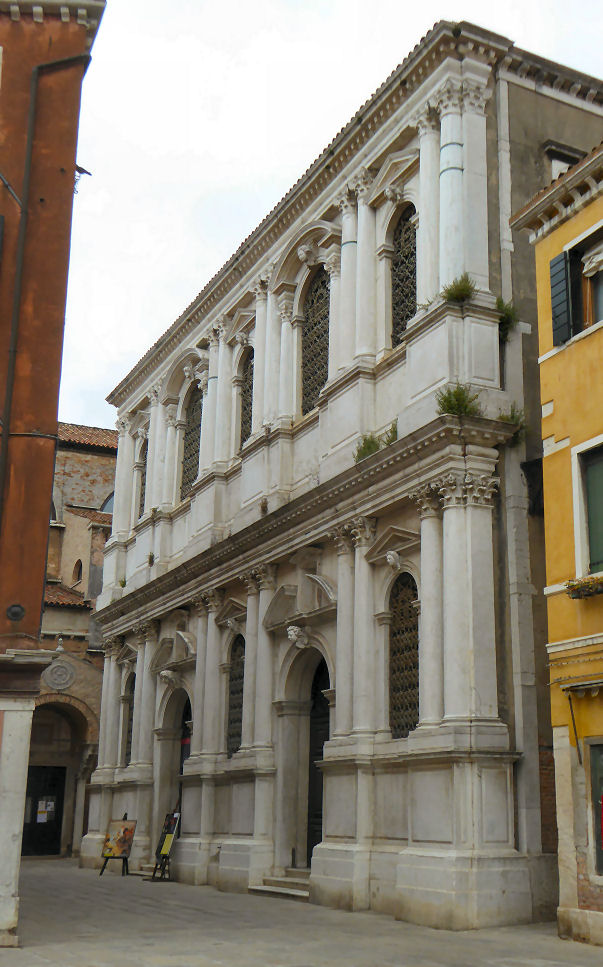
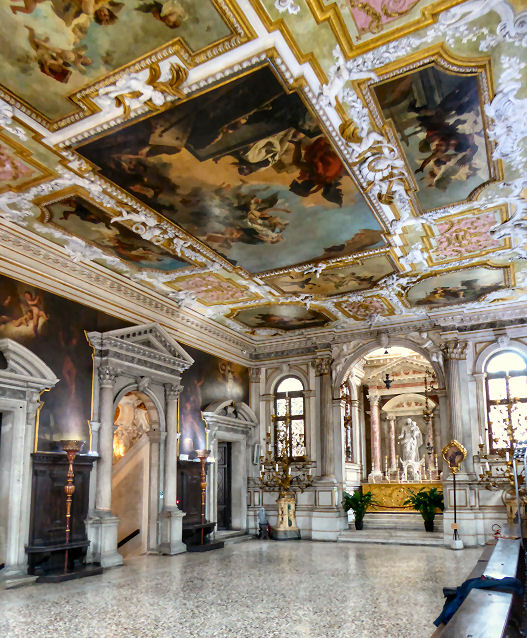
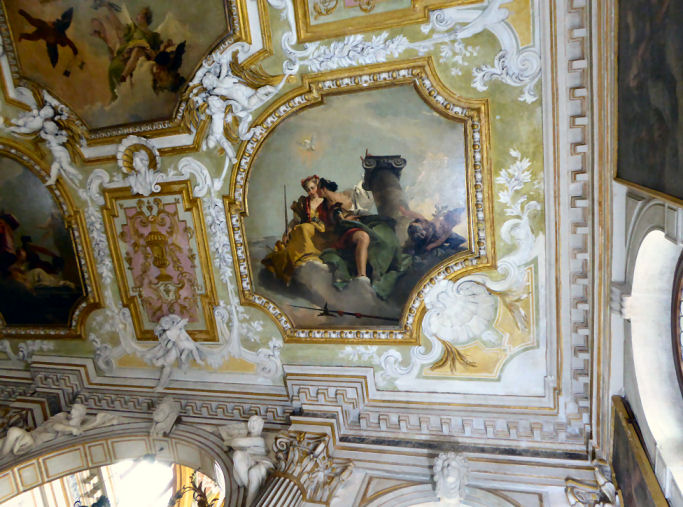
|
|
Misericordia |
|
History
The Scuola Grande di Santa Maria della Misericordia was founded on
the 8th of September 1261, with the old scuola hall built on land provided
by the Augustinian monastery of
Santa Maria Valverde from 1310, with
enlargement later in the century and rebuilding in the
1440s financed by the Bon family. This involved building the albergo
over the cloister, expanding forward into the campo and
erecting a new façade. The latter had a Gothic arch with a large miracle-working
relief of the Madonna della Misericordia attributed to Bartolomeo
Bon installed in 1451. The arch was demolished in 1612,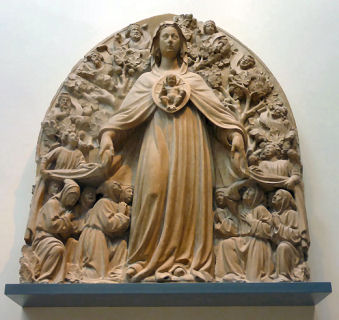 and the relief (see right) is
now in the Victoria and Albert Museum in London, along with other
sculptures from the scuola. and the relief (see right) is
now in the Victoria and Albert Museum in London, along with other
sculptures from the scuola.
The need for expansion (by the 16th century the scuola had 612 members) led to
the building of a new scuola to designs by Alessandro Leopardi from 1507.
Lack of progress beyond knee height led to Jacopo Sansovino being commissioned
to provide a new plan in 1532, but only the ground floor had been erected by the time of his death in 1570.
The confraternity was finally able to move into the new building in 1589.
The old scuola building, first rented to
a fodder merchant, became a hospice. It was later
used as a theatre. Now it's used as an art restoration centre, for both
sculpture and paintings.
This video shows
the large Titian Presentation at the Temple from the Sala dell'Albergo
of the
Scuola della Carità (now the Accademia) being
brought here for restoration in late 2010.
The new scuola, the huge and unfinished Gothic barn-like
building by Sansovino, became in 1634 the guildhall of the silk-cloth weavers' guild who renovated it in 1730.
From 1914 it was used as a gym and was restored
recently, at a cost of 10 million euros - funding provided by a private
company, with much controversy over their feet-dragging and lack of
progress for the four years from 2009. It is to be used for
biennale exhibits and the like (see photo right) having reopened
fully in March 2016.
Interior (Old
Scuola)
The plain main doorway leads into
a staircase hall with a coffered ceiling decorated with scuola symbols.
The sala del capitolo upstairs is so big Tintoretto used it to
paint his Paradise canvas for the Sala del Maggiore Consiglo in the
Doge's Plalace. The ceiling of the sala was decorated in1453-65 but
this has not survived.
Interior
(New Scuola)
On the ground floor the space is divided into three
by large Corinthian columns on tall pedestals (see photo below).
Upstairs are frescoes between the windows of the Twelve Major Prophets by Alvise da Friso. Paolo Veronese, Padovanino and Domenico Tintoretto
made paintings for the scuola too, some of which are lost. Local resident Tintoretto used the upper
rooms here to paint his huge Paradiso for the Palazzo Ducale.
Ruskin wrote
The church itself is nothing, and contains nothing worth the
traveller's time; but the Albergo de' Confratelli della Misericordia (i.e.
the old scuola) at its side is a very interesting and beautiful relic of
the Gothic Renaissance. Lazari says, "del secolo xiv.;" but I believe it
to be later. Its traceries are very curious and rich, and the sculpture of
its capitals very fine for the late time. Close to it, on the right-hand
side of the canal, which is crossed by the wooden bridge, is one of the
richest Gothic doors in Venice (see black and white photo below
right) remarkable for the appearance of antiquity in the general
design and stiffness of its figures, though it bears its date, 1505. Its
extravagant crockets are almost the only features which, but for this
written date, would at first have confessed its lateness; but, on
examination, the figures will be found as bad and spiritless as they are
apparently archaic, and completely exhibiting the Renaissance palsy of
imagination.
The general effect is, however, excellent, the whole arrangement having
been borrowed from earlier work. The action of the statue of the Madonna,
who extends her robe to shelter a group of diminutive figures,
representative of the Society for whose house the sculpture was executed, may be also seen in most of the later Venetian figures of
the Virgin which occupy similar situations. The image of Christ is placed
in a medallion on her breast, thus fully, though
conventionally, expressing the idea of self-support which is so often
partially indicated by the great religious painters in their
representations of the infant
Jesus.
was executed, may be also seen in most of the later Venetian figures of
the Virgin which occupy similar situations. The image of Christ is placed
in a medallion on her breast, thus fully, though
conventionally, expressing the idea of self-support which is so often
partially indicated by the great religious painters in their
representations of the infant
Jesus.
Opening times
For exhibitions of modern art
Vaporetto
Madonna dell'Orto
map
There's a
Website in Italian
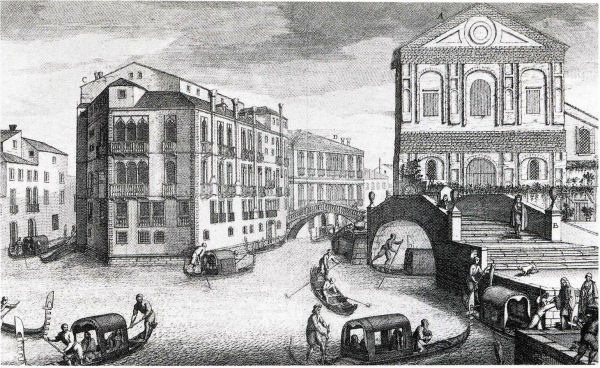
|
|

The old scuola (above) and the new one (below).
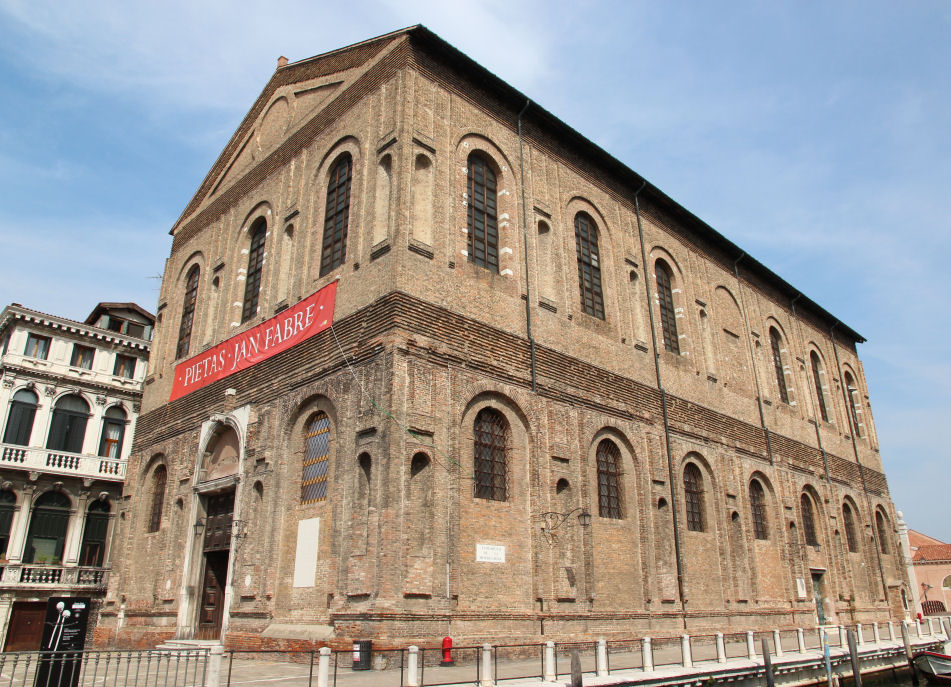

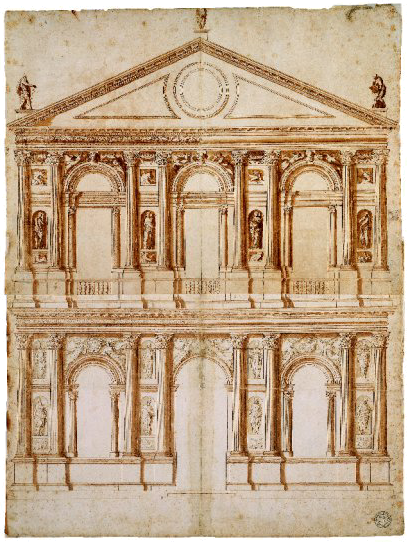
A drawing by Palladio
|
|
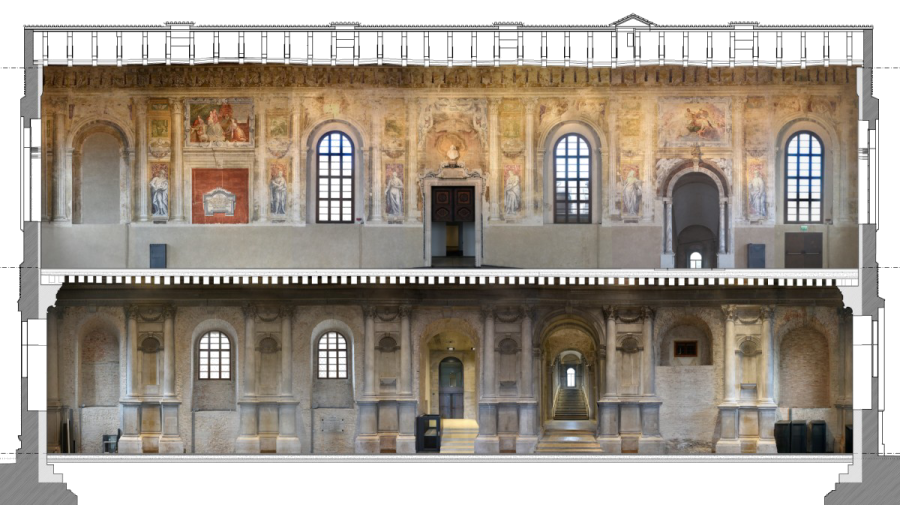
|
|
San Giovanni Evangelista |
|

|
History
The order's
monogram SZ (see right) stands for San Zane, Venetian
dialect for Saint John the Evangelist.
The original Order of Flagellants was founded
in March 1261, making it the third oldest after the Carità and San Marco, founded the year before.
They initially met at the
church of
Sant’Aponal before moving in 1301 to the
church here, having been granted permission to use the Badoer family
chapel.
In
1340 they rented dilapidated rooms on the upper floor of the ospizio
(asylum) building here, also from the Badoer family. From the building work
of 1349/50 that followed an Istrian stone relief, of the brothers in cowls
holding their scourges and kneeling
before their Saint, remains (see photo below right), as well as possibly the
capitals in the Hall of Columns.
The membership and resources grew and on December
23rd1369 in the church here the Scuola was
given a fragment of the True Cross by Philippe de Meziéres, the French
Grand Chancellor of the Kingdom of Cyprus. The relic immediately began
working miracles and pilgrims follwed. So it was decided,
following the acquisition of the hall of the old hospice building in 1389,
to build permanent. This involved the building of the Hall of Columns and
the addition of a second room on the second floor, the Oratorio della
Croce, to house the the relic. After 1420 Jacopo Bellini (who become a
brother here in 1437) was entrusted to provide a sequence of paintings, to replace earlier works by the likes of Giovanni da Bologna. The end of this cycle of works is
commemorated by a plaque below the previous one, dated 8th March 1453
(actually 1454 due to old style calendar).
From 1478-81 Pietro Lombardo built the famous
gorgeous marble screen (septum) to enclose the calle (see right) and in the 1490s Marco Codussi was
employed to raise the floor of the
meeting house, enlarge the windows of the main meeting room, and
create a new entrance and the double monumental staircase for grand processions,
just as he had built at the Scuola di San
Marco. (The entrance portal to the Hall of Columns is also sometimes attributed to Gentile Bellini.)
It was at this time that the Scuola commissioned the likes of Perugino,
Carpaccio, Gentile Bellini and Mansueti to paint the Miracles of the
Cross cycle for the Oratory of the Cross, to celebrate the order's
cross relic, which was kept there.
A new wing was built 1540-44 to create a new Albergo to free up the
Salla della Croce from its double duties. Titian painted the ceiling of
this new albergo around 1544-48.
The Scuola was suppressed by Napoleon in 1806/7 and in
1814 the Austrians used the buildings as a warehouse for the storage of art looted
from the other religious institutions. There are surviving plans to build housing
here in the mid-19th century. A new confraternity was established in
1929, which was acknowledged by Pope Pius XI on 7th March 1931 and which
thrives still.Interior
Access to the main rooms is up an
impressive staircase by Codussi. You first enter the huge and spectacular
Sala Capitolare (see photo right) created during the rebuilding work of Giorgio Massari in the
early 18th century, including the fine intarsia floor, with large canvases down each side and many panels on
the ceiling, all depicting scenes from the life of the Scuola's name saint
by the likes of Domenico Tintoretto, Marieschi, Balestra, Guarana, Diziani
and even Longhi. Over the altar at the end is a statue of Saint John
the Evangelist, with an eagle and cherub, by Giovanni Maria Morleiter
around 1732/3. The doors either side lead to the Sacristy and the
Chancellery, the so-called Stucco Rooms. One contains reproductions of the
Miracles of the Cross cycle painted for the Oratory of the Cross
here.
Next there is the Oratory of the Cross which
has housed the Relic of the Cross since the late 14th century and is where the
Miracles of the Cross cycle by Gentile Bellini and Carpaccio and others,
and supervised by Gentile,
used to live. From 1784 to 1788 the medieval oratory was transformed by
Bernardino Maccaruzzi, a student of Massari, with gilt pastel stucco work
and paintings by Francesco Maggiotto on the ceiling. The walls have unspecial works,
mostly from the late 16th century, hung to replace the famous
Miracles of the Cross cycle.
The small Sala dell'Albergo has four panels by Palma Giovane,
just as you might be thinking this might be one place in Venice without
examples of his work, but they are odd scenes, and there's also a rather
nice 14th-century Byzantine panel of the Madonna Platytera. It was found
in the sacristy of the church being used, face down, as a floorboard. It
is signed Franciscus Pinsis - not a known name amongst artists of the
period. Its asymmetry points to it having been cut down, and a missing
Saint Paul on the right.
The even smaller final room, the Archive, is now
also called the Guarana Room,
as a ceiling panel and two overdoor panels by Jacopo Guarana from 1762 are to be found
here.
Lost art
A Madonna of Humility panel by Giovanni da Bologna (early 1380s)
removed to make way for the Jacopo Bellini works mentioned below, is now in
the Accademia. It also features an Annunciation, Saints John the
Baptist, John the Evangelist, Peter, and Paul, and members of the Scuola
From the
commission of 1421 from Jacopo Bellini and his workshop of scenes from the
Life of the Virgin, Ridolfi recorded 17 scenes (and an altarpiece) and
nine survive. The Annunciation and The Birth of the Virgin,
are in the Turin Galleria Sabauda; The Marriage of the Virgin and
The Adoration of the Magi were in the Stanley Ross Collection, but
were sold by Christie's (as being by Giovanni, following recent scholarly
theories that they are the earliest surviving works by him) in May 2019. Five more recent discoveries are The
Visitation (see photo below), The Presentation of Christ, The Wedding at Cana, Christ Among
the Doctors and The Meeting at the Golden Gate, all now in a
private collection in England, possibly that of the Earl of Oxford and
Asquith. All nine suffered from intrusive restoration when in the
collection of Natale Schiavone, probably by his son Felice, a painter and
restorer of old masters. This restoration work has since been reversed on the
gallery-owned pictures, but not on the majority of those in the English
private collection.
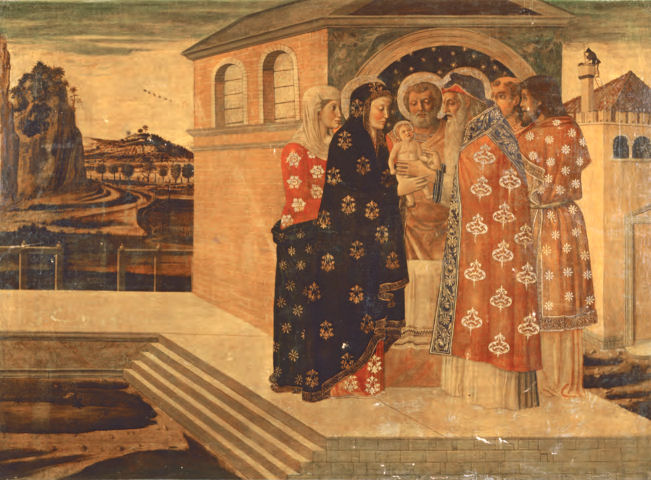
The two-page frontispiece from the c.1330 Mariegola of the scuola
here is divided between Cleveland and Paris. They depict Christ in Majesty
with Saint John the Evangelist and the Flagellation, respectively, and
have been attributed to the Master of the Washington Coronation, an artist
in the ambit of Paolo Veneziano.
The Miracles of the Cross cycle
Of the ten canvases painted for the Miracles of the Cross cycle for
the
Sala dell'Albergo, called the Oratory of the Cross, the Perugino Miracle of the Vendramin Ships
was destroyed and replaced in 1588 by a canvas by Andrea Vicentino, also
now lost. A canvas by Mariscalco had disappeared by 1664. The rest, as listed below, are in the
Accademia, entering the collection in 1820.
May 2022 update The two famous canvases by
Gentile Bellini and the one by Carpaccio were away undergoing
restoration at the Misericordia. One can only hope that the rest of the
cycle will get similar treatment, not just those by the big names, or the
clean/dirty contrast will be obvious.
Click here for a
virtual reconstruction of the Oratory of the Cross in the early 16th
century
Vittore Carpaccio
The Miracle of the Cross at the Rialto Bridge 1494 (see photo right).
Carpaccio, who was probably a pupil of GentileBellini, shows the miraculous cure of a possessed boy by Francesco Querini the
Patriarch of Grado, on the loggia above left. The wooden bridge of 1458 is still to be seen, which
collapsed in 1524 and was replaced by the current stone bridge. Members of
the confraternity can be seen carrying the relic across the bridge, as
they would have done before the events on the patriarch's loggia. The
campanili of San Giovanni Cristostomo and Santi Apostoli (rebuilt in 1672)
can be seen on the skyline.
Givanni Mansueti
The Miracle of the True Cross at the Campo di San Lio
1494
Depicts the 1474 funeral of a member of the brotherhood whose
devotion to the relic had been less than fervent so that it became too
heavy to carry until the parish priest of San Lio tried. A sign on a house
to the right reads Casa da fitar ducati 5 ('House to let, 5
ducats').
The Miraculous Cure of the Daughter of Ser Benvegnudo of San Polo
c.1505
In 1414 she was cured of the paralysis she's suffered since birth
by touching the three candles that her father had placed by the relic.
Gentile Bellini
The Procession of the True Cross in the Piazza San Marco
1496
The first and most famous of Gentile's paintings for the scuola,
and the largest.
It depicts a procession on the 25th of April 1444, the feast of Saint
Mark, when Jacopo de' Salis, a
merchant from Brescia who sought and received the cure of his injured son,
a miracle which actually occurred in Brescia.
The painting's lasting fame rests mainly on its depiction of the Piazza
before the changes of the 16th century. The original mosaics on the
Basilica, now lost, are visible but the campanile, built in the year of
the painting, is not. That's not to deny that Gentile moved buildings and
adjusted the perspective.
The
Miracle of the True Cross at the Bridge of San Lorenzo 1500
Held the central position opposite the window. Legend has it that
between 1370 and 1382 during a procession opposite San Lorenzo the relic
fell into the canal, where it floated and resisted rescuers until the
Guardian Grande Antonio Vendramin tried his hand and succeeded. In the
crowd to the left are Caterina Cornaro and her ladies and to the right may
be the painter's family but, although undoubtedly portraits, are more
likely members of the confraternity.
The Miraculous Healing of Pietro dei Ludovici
(see photo right).
The curing of a quartan fever, a form of malaria, was achieved by
the touching of a candle that stood by the reliquary. The setting may be
the church of San Giovanni Evangelista as it appeared then.
Lazzaro Bastiani The Donation of the Relic of the True Cross c.1495
Shows the presentation of the relic by Philippe de Mezéires as if
it had occurred in the church of San Giovanni Evangelista, viewed from
outside.
Benedetto Diana Miracle of the Relic of the Holy Cross
1505-10
On the 10th of March 1480 the four-year-old son of Alvise Finetti, a
scribe at the Office of Loans, fell from an attic but was then found to
have been miraculously cured by the fragment of the True Cross belonging
to the Scuola.
A central ceiling panel painted by Titian for the new Sala dell'Albergo
around 1545/6, The Vision of Saint John on Patmos, is now in the National
Gallery in Washington. It was surrounded by nineteen smaller panels by
Titian and his studio depicting The Four Evangelists, satyrs and putti,
which are all in the Accademia, except for the one which is lost. The
centrepiece had also been in the Accademia, but they traded it, with three
other works, with a dealer for a painting by Bartolommeo Schedoni. It was
sold, disappeared, and then was bought by the Kress Foundation, who have
loaned it to the Washington National Gallery.
Opening times
The scuola and church are open to the public on variable, but
previously announced, days.
Check their
website for the times of future open days.
Entrance fee €10
Vaporetto San Toma
map
|
|
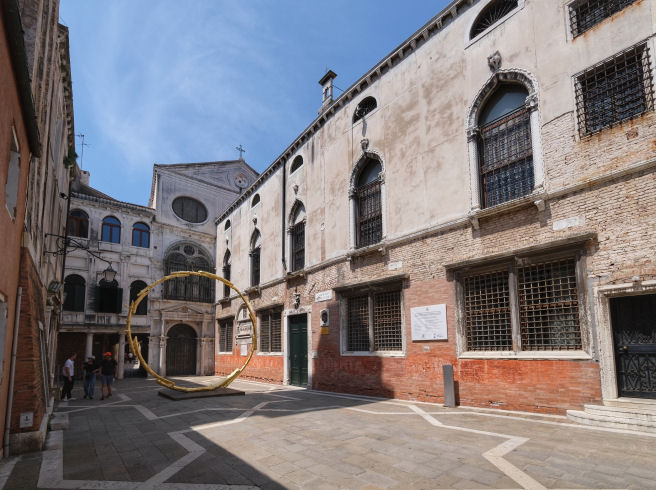
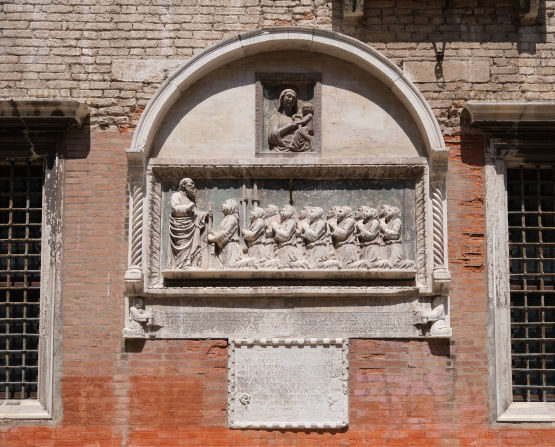
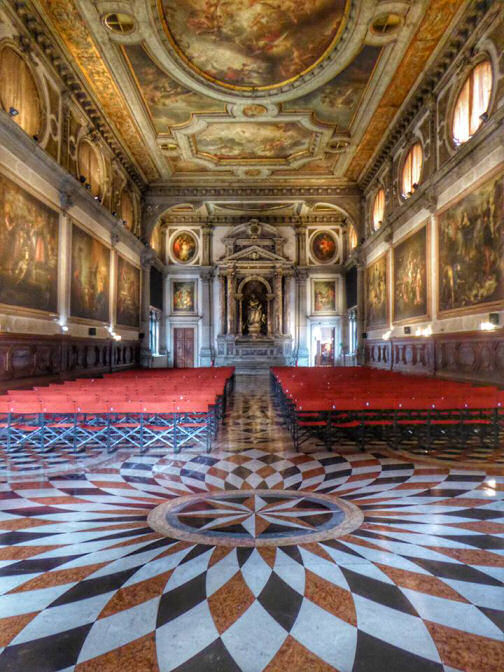
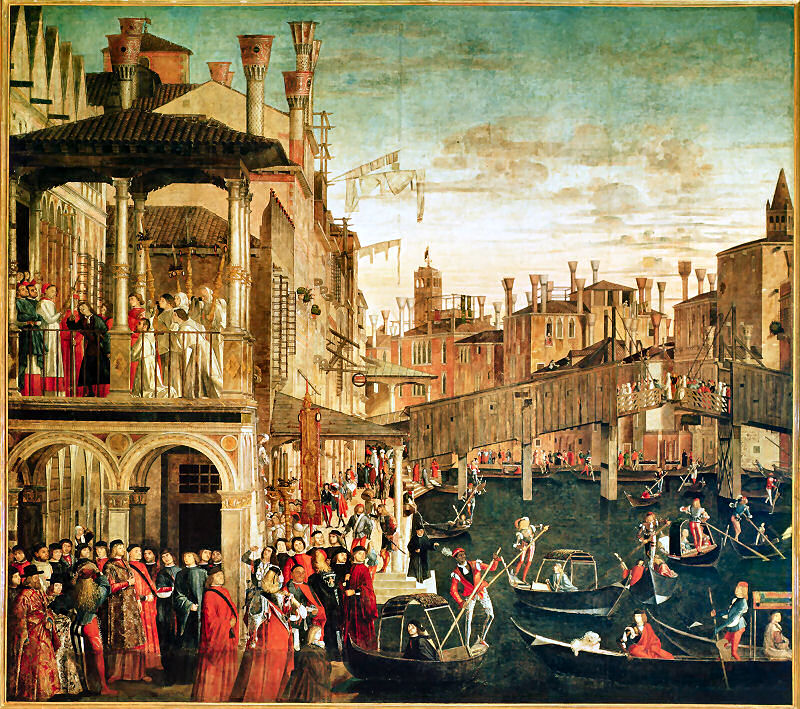


|
|
San Marco |
History
The confraternity was initially
founded in 1260 as a Scuola dei Battuti based in the sestiere of Santa Croce
at the church of
Santa Croce, later demolished. In 1438 it moved to
its present location beside San Zanipolo, on land obtained the previous
year from the Dominicans next door. But nothing is known
of this 15th-century building as it was burnt down on 31st March 1485 when
candles left lit on the altar in the Sal Capitolare set fire to curtains. Paintings by Jacopo Bellini, Gentile Bellini and Bartolomeo Vivarini,
commissioned by the officers of San Marco in 1466, also perished in the
fire. Given the opportunity the scuola decided to rebuild and expand. By
1490 the new meeting house was largely complete and decoration could
begin.
In the early 16th century Gentile Bellini (a member of the scuola) began a series of
paintings on The Life of Saint Mark for the Sala
dell’Albergo. And around 1523-4 various Venetian artists were commissioned
to decorate the Sala Grande.
Decoration in the Sala Grande continued into the 17th century. The
scuola was suppressed by Napoleon in 1806, and the art dispersed, the buildings
being converted into a military hospital for the Austrians and eventually becoming part of the Ospedale Civile.
The scuola reopened as a cultural centre in 2013.
The façade
Pietro Lombardo and collaborator Giovanni di Antonio Buora were
responsible for the lower part of the façade. Some sculptures from the old
façade were reused - the figure of Charity above the portal and a
relief of Saint Mark Venerated by Members of the Confraternity in
the lunette below both thought to be by Bartolomeo Bon. At pavement level Tullio Lombardo, Pietro’s son, created the four three-dimensional reliefs
of the two false-perspective lions, together with Saint Mark Healing Anianus and
Saint Mark
Baptizing Anianus. Marco Codussi took over in 1490, designing the
upper windows and the top storey of the façade.
The building
The Scuola di
San Marco has just recently been renovated and reopened in 2013. Entry is up
Mauro Codussi's staircase, destroyed in the 19th century but rebuilt to
Codussi's plans. It is accessed through one of the pair of doorways he
designed, in the right wall of the also-cleaned large vestibule (see
photo below) with its ten Corinthian columns on tall pedestals, which is still the entrance to the hospital.
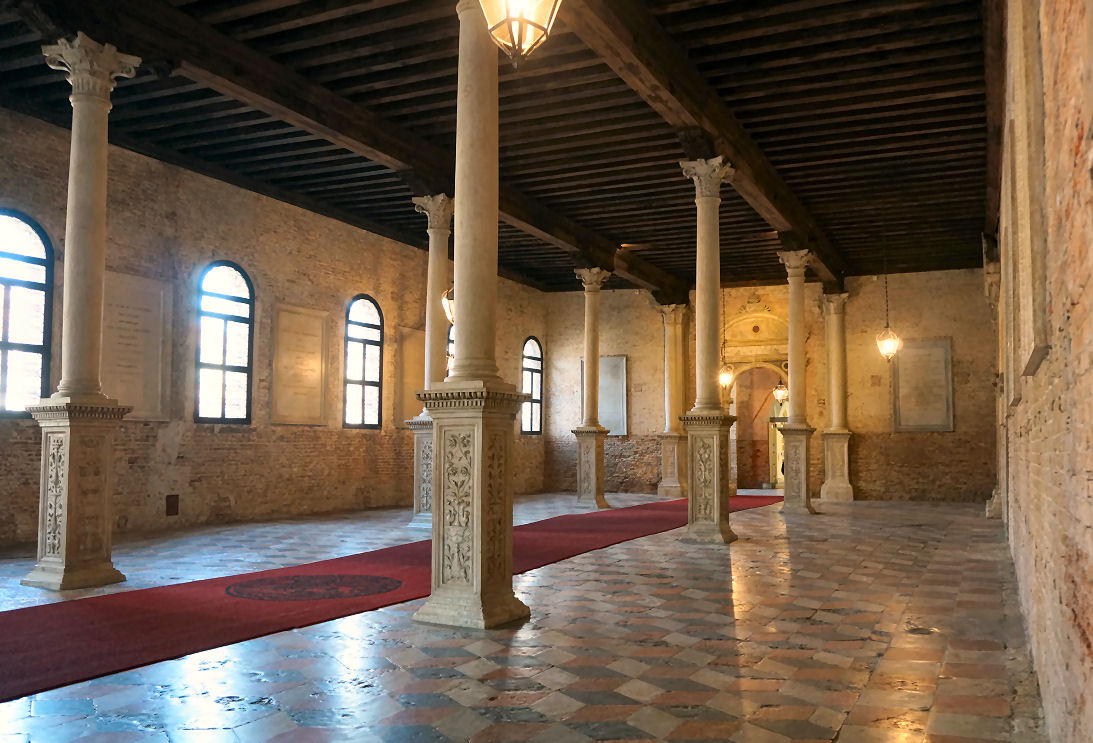
The Chapter Hall (see photo right) has a spectacular gilded
ceiling of 1519 by Vettor Scienzia da Feltre and Lorenzo di Vincenzo da
Trento, modelled on the earlier ceiling. Also in here are some big impressive paintings, and large display cases full of
medical bits and books, the Scuola still being owned by the Ospedale. It's good that the tags in the cases already look
dusty and fly-blown, like at the best neglected museums of medical
equipment. So you find yourself staring at a waffle-ironish thing,
thinking how rarely waffles have a pointy design on them, and then you
roughly translate the Italian and learn that you're looking at a suppository
press.
Tintoretto's Saint Mark Rescuing the Slave (1548) (now in the
Accademia) once hung on
the wall opposite the the altar between the windows overlooking Campo San Zanipolo. All of the art in this hall
and the Sala dell'Albergo was dispersed in 1797, few originals remain in
here.
There's a 1622 Wedding at Cana by Padovanino, taken from
San Giovanni di Verdura in Padua.
The high altarpiece is Christ in Glory with Saints Mark, Peter and Paul
of 1614 by
Palma Giovane, commission from him after Domenico Tintoretto failed to
produce an altarpiece on time. (There is a rather nice design drawing of
it in the Victoria and Albert museum.) It is flanked by two scenes relating to Venice's acquisition of
Saint Mark's body by Jacopo and Domenico Tintoretto. Elsewhere in this hall
you'll find Saint Mark Blessing the Origins of Venice also by them, but with more input from Jacopo than the Domenico-dominated pair
flanking the
altar.
The smaller Sala dell'Albergo (see photo right) opens off of the Sala Grande.
The carved and gilded ceiling here is by Biagio and Pietro da Faenza and
is from 1504. In here digital
reproductions replace the paintings originally sited above the
bookcases. The Preaching of Saint Mark by Gentile Bellini
(completed by his brother Giovanni in 1515 and the most famous work here,
with a weird building in the background looking like a cross between the
Basilica San Marco and a teapot) is on the end wall, and The Martyrdom of Saint Mark (started by
Giovanni and finished by his pupil Vittore Belliniano in 1526) is on the entrance wall. Three more scenes were added by
Gentile Bellini's pupil Giovanni Mansueti between 1518 and 1526 and hung
on the right side wall, with
Paris Bordone's Presentation of the Ring to the Doge of Venice 1534
and
Palma Vecchio's Saint Mark Saving Venice from the Ship of Demons on
the left as you enter. The Bordon is considered his masterpiece and
depicts the fisherman who, according to legend, presented the Doge
with the ring of Saint Mark, the saint having presented it to him as proof
of some miracles that he had witnessed the night before. The Palma Vecchio was copiously praised by
Vasari, but he said that it was by Giorgione in the first (1550) edition
of his Lives, switching to Palma in the second (1568) edition. All the originals are elsewhere (see
below) but the reproductions here make an impressive display.
Lost art
The series of paintings of The Life of Saint Mark for the Sala
dell’Albergo mentioned above are all now elsewhere. Gentile and Giovanni Bellini’s
Preaching of Saint Mark in Alexandria is in the Brera, where it is
overwhelmingly huge and impressive at eye level. The figures in the left
foreground are most characteristic of Giovanni, who finished the work
after the death of his brother. The
Martyrdom of Saint Mark in Alexandria by Giovanni Bellini and Vittore
Belliniano is in the Accademia. Of the three by Giovanni Mansueti the tall
and narrow
Saint Mark Baptising Anianus, with its dizzying architecture, is in the Brera, Saint Mark
Healing Anianus and Episodes from the Life of Saint Mark are in
the Venice Accademia. As are Paris Bordone's Presentation of the Ring
to the Doge of Venice of 1534 and Palma Vecchio's Saint Mark Saving
Venice from the Ship of Demons, thought to have been completed by
Bordone. This last work had been on loan to the Ospedale Civile from 1948
until quite recently. The works now in the Accademia have recently been
made into a room reproducing their positioning in the Sala dell'Albergo.
Four by Jacopo Tintoretto for the chapter hall: The dramatic Saint Mark
Freeing the Slave
of 1548 was the work which made his name, despite the confraternity
having initially argued about whether to accept it, and an angry
Tintoretto taking it back and keeping it for a while. It had been
commissioned the year before, when the Guardian Grande was Marco
Episcopi, the father of Titian's future wife Faustina.
It and The Stealing of
the Body of Saint Mark (see right) and Saint Mark Saving the Saracen are all in the
Accademia. The last one, the spooky Finding of the Body of Saint Mark is in
the Brera. These last three were all commissioned, as his own expense,
by Tommaso Rangone (who is therefore depicted left of centre in The Stealing...)
the Guardian Grande here at the time and date to c.1562/6. Following a mystery dispute
they were removed a few years after installation and on the 10th of August
1573 sent to Rangone's house. On September 8th he returned them to
Tintoretto who promised to 'finish them perfectly'. They were returned to
the scuola where they remained until 1807.
Eight figures of prophets and sibyls, plus one of Saint Mark, also by
Jacopo Tintoretto are now lost, as are two narrative panels by his son
Domenico.
Domenico Tintoretto's later
painting of The Dream of Saint Mark of 1585/6
is in the Accademia too, where it's been since 1924. It depicts the saint,
sailing to Rome from Aquileia, waylaid by a storm which drove his boat
towards the Venetian islands. An angel later appears to him in a dream
telling him that his remains would one day return to the place where he
was having this vision, and that the city of Venice would be built and
that he would become its patron saint. This somewhat self-serving story
doesn't appear in the Golden Legend, but it does features amongst the
mosaics in the Basilica.
A bifolium from a mariegola (account
book) for this scuola of c.1350, now in the Correr Museum, has been
attributed variously to Paolo Veneziano, an unknown painter close to Paolo,
and to
Lorenzo Veneziano.
The scuola in art
Santi Giovanni e Paolo and the Scuola de San Marco by
Canaletto is a typical view. But there's a painting by Bernardo Bellotto
called The Rio dei Mendicanti and the Scuola di San Marco in the
Accademia where the Scuola doesn't co-star with the church.
Opening times
Tuesday to Saturday
9.30-13.00, 14.00-17.00
Free entry
Vaporetto Ospedale
map
The scuola has a
Website
|
|
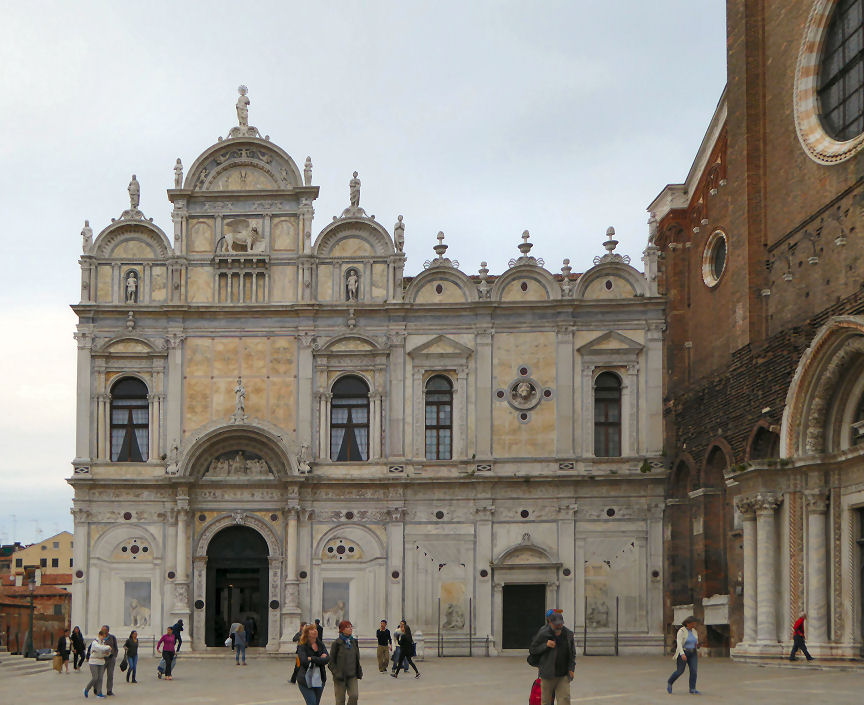
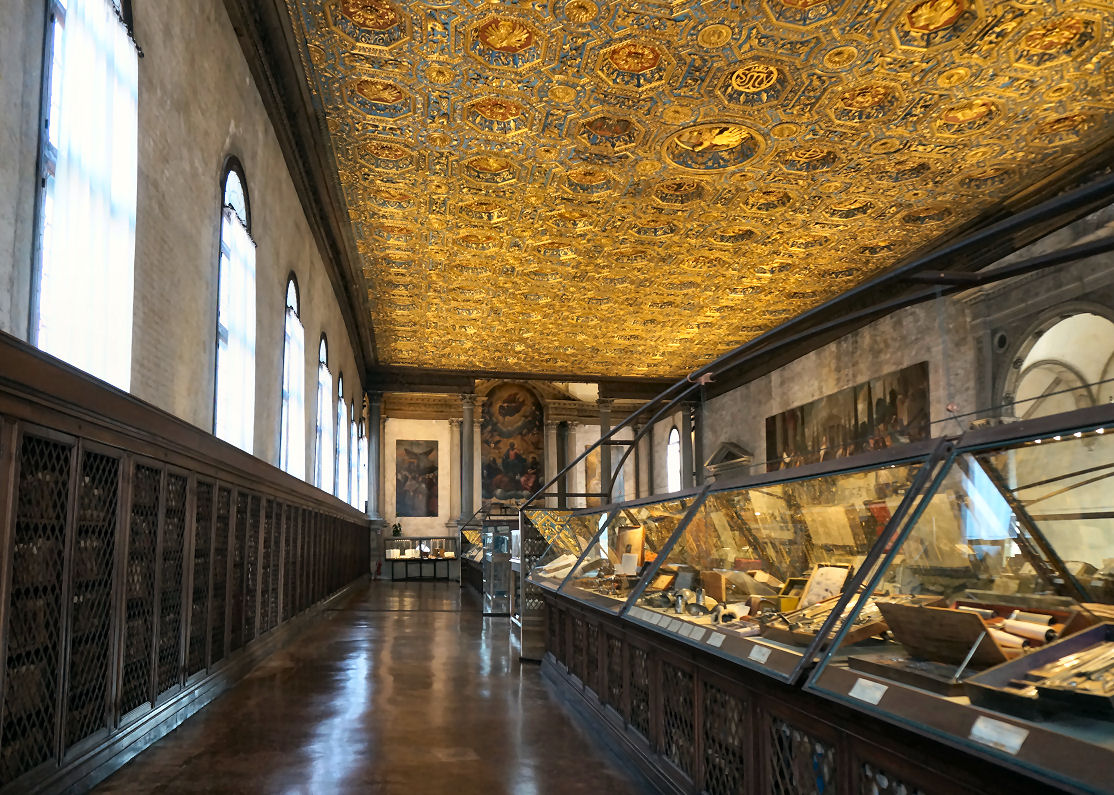

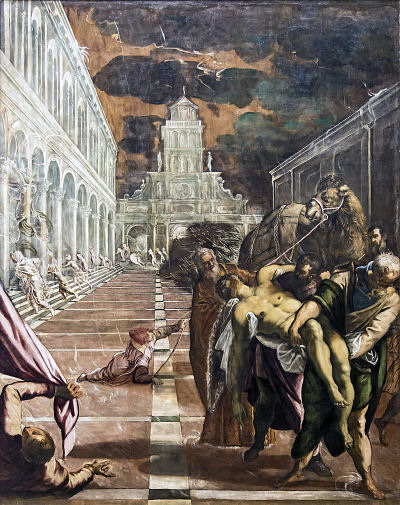 |
|
San Rocco |
History
Founded after
the plague of 1478 with initially limited resources. Finances
improved, however, with the increased veneration of the dedicatory plague saint, following
further
outbreaks of plague in 1527 and 1571, and so by the end of the 16th
century it was the richest of all the Scuole Grande. It was the only scuola
to build its own church, begun
in 1489, consecrated in 1508 and rebuilt in the 18th century. The building
of a meeting house was begun in 1517, across the square from the
church, first by Pietro Bon, the architect of the church, who was
responsible for the ground floor. He was followed by Sante Lombardo and then, from 1527, by Antonio Scarpagnino,
who finished the upper part of the façade and unified the whole with
columns. Work was completed in 1560, resulting in the largest and grandest
of the scuole, and it remains the least changed. resources. Finances
improved, however, with the increased veneration of the dedicatory plague saint, following
further
outbreaks of plague in 1527 and 1571, and so by the end of the 16th
century it was the richest of all the Scuole Grande. It was the only scuola
to build its own church, begun
in 1489, consecrated in 1508 and rebuilt in the 18th century. The building
of a meeting house was begun in 1517, across the square from the
church, first by Pietro Bon, the architect of the church, who was
responsible for the ground floor. He was followed by Sante Lombardo and then, from 1527, by Antonio Scarpagnino,
who finished the upper part of the façade and unified the whole with
columns. Work was completed in 1560, resulting in the largest and grandest
of the scuole, and it remains the least changed.
By the mid-16th century the interior was ready to be decorated and
in 1563 the Scuola decided to decorate their Sala dell'Albergo.
They invited drawings for designs for the ceiling oval from Giuseppe
Salviati, Federico Zuccaro, Paolo Veronese and Jacopo Tintoretto. Vasari
and Ridolfi both tell us that Tintoretto beat all-comers by obtaining the
dimensions of the oval space in the ceiling and installing a painting on the day of
judging. (Veronese's drawing for this competition is in the Gardner Museum
in Boston.) This work San Rocco in Glory (see below right) won
Tintoretto the commission, and is arguably the best work he produced here.
Tintoretto worked here from 1564-67. In 1565 he was accepted into the
confraternity and they commissioned him to paint the huge
Crucifixion in the Sala dell’Albergo. His later work seems to have
been on his own initiative and for little or no pay. During 1566-7 he painted three
further scenes from the Passion, Christ before Pilate, The Way to Calvary
and a Pieta. In 1575 he began work on the Salone Maggiore with scenes on the
ceiling illustrating the charitable functions of the brotherhood,
while the walls were painted with scenes from the New Testament.
Between 1583 and 1587 Tintoretto returned to paint the lower meeting room
(Sala Inferiore) with eight scenes from the Life of the Virgin. In all he made 64
paintings, almost all in oil on canvas, with only eight diamond-shaped
monochrome canvases painted in tempera. These latter deteriorated and were
replaced in 1777 by copies by Giuseppi Angeli.
The Scuola di San Rocco
escaped suppression by Napoleon and still functions as a confraternity
Interior
All the paintings are by Tintoretto unless otherwise described. The
Sala Terrena on the ground floor,
with its two rows of five columns, has three big panels down the left, of
which the first, an Annunciation, is probably the best and most famous.
It presents an unusually run-down and cluttered scene. A
pair of small panels flank the altar on each side wall. They are of Mary
Magdalene and Mary of
Egypt and they match but both landscapes are a bit bosky for deserts. There are two more panels on
the right-hand side with door tops chopped out of them. The one on the right,
an Assumption, shows just how busy and baroque Tintoretto can get.
It is, though, thought that this downstairs sala has more input from his
assistants, including his son Domenico, partly because he was around 70 by
this time, although the Annunciation and the Assumption,
being important episodes, are thought to be largely his work.
The grand staircase takes you first to a half-floor, where a Titian
Annunciation and The Visitation by Tintoretto have now been
returned to their 16th century positions. The fresco decorating the small
dome at the top of the staircase is by Giovanni Antonio Fumiani,
responsible for a ceiling panel in the church of San Rocco and the vast
ceiling of San Pantalon. The final long flight of stairs is flanked by
enormous works by Pietro Negri and Antonio Zanchi.
Then you reach the Sala Grande. Weird big lamps
throw bright shadows across the weird carved wooden allegorical figures
(by Francesco Pianta in the 17th century) in the panelling at
human height, whilst everything above and overhead is by Tintoretto. The
twenty-one ceiling panels are of Old Testament scenes, with the side walls telling
ten New Testament stories. I like
the Nativity in the back left corner, with the crib on the stable's
mezzanine, and the Baptism next to it is just plain odd. The subjects are a
seemingly random selection of stories with the back wall's Saints
Sebastian and Rocco the most to the point. But I read later
that the seemingly odd, non-chronological, arrangement of scenes is
actually a thematic arrangement with scenes cross-referencing.
But the adjoining Sala dell' Albergo has the highlights
- the huge Crucifixion is one of Tintoretto's very best.
The ceiling panels are very decorative, full of allegories of the Four
Seasons,Virtues and the other Scuole Grandi, but the famous San Rocco in
Glory in the centre
(see right) shines and has queasy trompe l'oeil appeal. Facing the Crucifixion
are the oddly-ordered Passion scenes of
The Ascent to Calvary, "Ecce Homo" and Christ before Pilate.
The scuola in art
The Doge Visiting the Church and Scuola di San Rocco by Canaletto,
is famous and in the London National Gallery. Less well known is his
unfestive and plainer Scuola di San Rocco in the Woburn collection. It has
a viewpoint slightly to the left of the National Gallery painting and so
includes a distant view of the campanile of San Pantalon.
The scuola in fiction
The Spy of Venice: A William Shakespeare novel by Benet Brandreth
features Tintoretto as an important character and the Scuola (and church)
of San Rocco in a couple of key scenes.
Opening times
Daily 09.30 – 17.30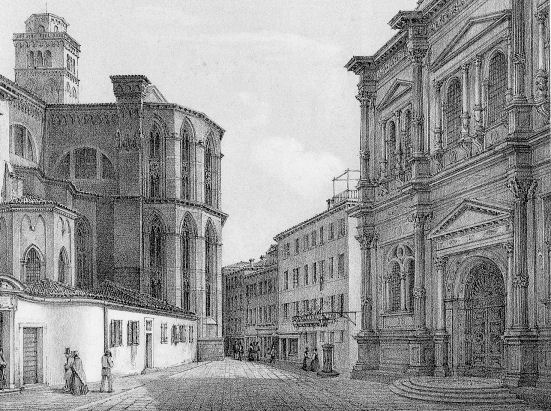
Vaporetto San Toma
map
The scuola has a
Website in Italian
|
|
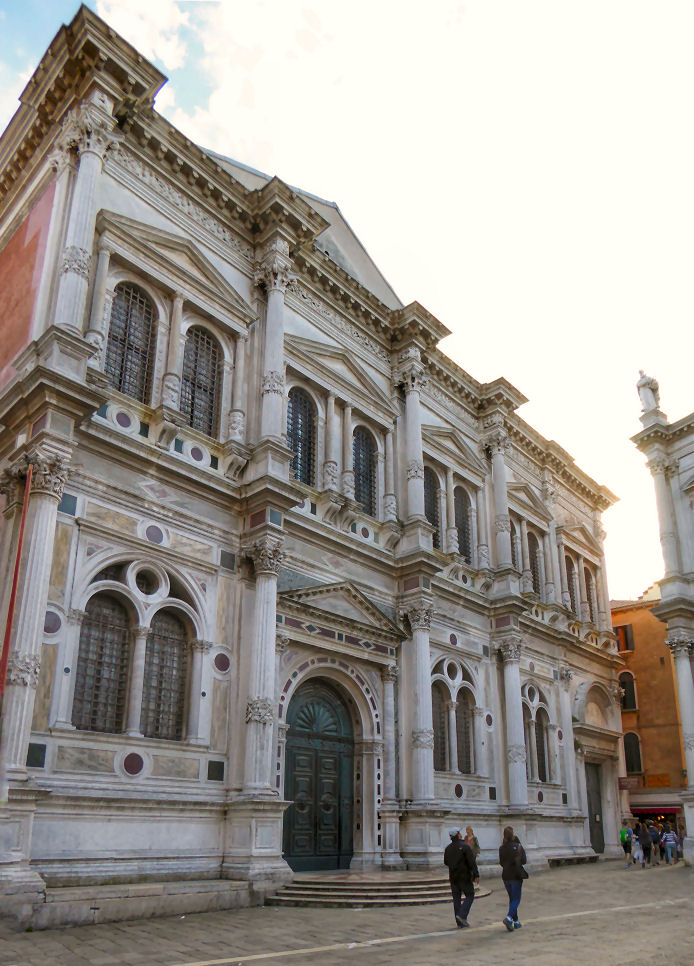
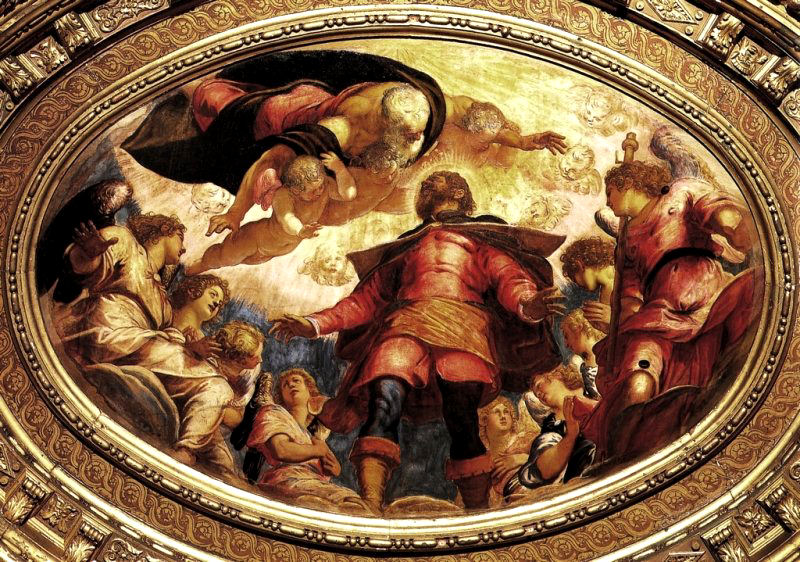

|
|
San Teodoro |
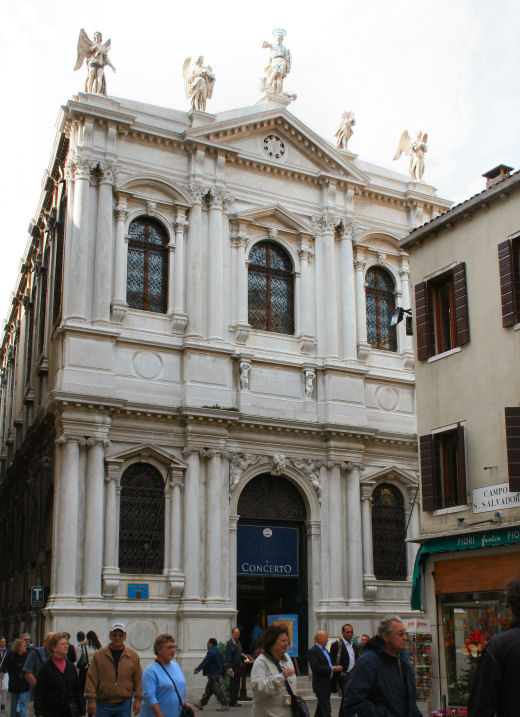 
History
This was originally a
scuola piccolo in honour of Saint Theodore, Venice’s patron saint before Saint Mark,
and they claimed to have been founded in 1258. It was the last
scuola to be granted
Scuola Grande status, in 1552. Not until 1556 did they decide to build
a meeting house but only in 1576 did land became available
opposite the church of San Salvador, where they had met hitherto, to build
big. Two large meeting halls were
constructed one on top of the other. In the 17th century Jacopo Galli
bequeathed enough funds for the scuola to commission Giuseppe Sardi and
Baldassare Longhena to build a grand façade and a double staircase. The
confraternity was dissolved by Napoleon and the halls are now used for concerts and exhibitions.
In the early 20th century it was used as a cinema, the Cinema Teatro
Massimo, much to the disgust of The Bystander, a British magazine
of the period (see right).
Lost art
A Martyrdom of Saint Teodoro from this scuola has been
attributed to Federico Cervelli, who is said to have taught Sebastiano
Ricci.
Opening times
For concerts and exhibitions.

Campo San Salvador
by Canaletto c.1736, Private collection,
London. |
|

|
|
Albanesi |
History
The Scuola degli Albanesi was established on the 22nd of October 1442 for
Venice's
Albanian Catholic community. Like the Scuola
degli Schiavone it was for immigrants from the Dalmation coast who had
suffered Ottoman invasions, and who also
employed Carpaccio.
Initially the members met in the monastery church of San Gallo. The Virgin
and Saint
Gall were chosen as the patrons of the Scuola.
In 1448 the Scuola moved to the church of San Maurizio, this latter saint then
being added
as the third patron of the Scuola. In 1489 the scuola acquired land
next to the church and the present scuola building (attached to the left
side of the church) was begun in 1497 and finished in 1502, when the lower
floor's ceiling was commissioned. Carpaccio's paintings date from the
years immediately following.
By
1532 the façade was finished and decorated with sculptural panels likely by the studio
of Giovanni Battista da Scarona. Between the windows a shallow relief
panel commemorates The
Sieges of Scutari in 1474 and 1478/9 (See right for a watercolour copy)
There are also the coats of arms of Antonio Loredan and Antonio Da Lezze, the heroes of these sieges. Below are
three deeper relief panels (sometimes attributed to the Lombardo brothers workshop)
which depict the Virgin and Child
flanked by Saints Gall and Maurice.
Membership dwindled so in 1780 the Scuola was closed down and the building became home
to the Scuola dei Pistori (bakers). In 1806 the scuola, and all the other
Venetian confraternities, was closed by Napoleonic laws and its works of
art dispersed. The building was converted to residential use. A second
upper floor has replaced the original pitched roof.
Lost art
Carpaccio and his workshop painted six square scenes from Life of Virgin for the
smallish sala dell'allbergo
on the upper floor here between 1502 and 1507. They lined the left wall,
with benches against the right wall and the altar at the short end
opposite the windows. The painted light of the panels
appropriately comes from the left.
The
Birth of the Virgin (see
right) is in the Accademia in Carrara and has the reputation as the
best panel, with the most participation of Carpaccio himself. It has been
dated as the first in the series with the suggestion that it may have been
a presentation piece to win the commission for the whole cycle. In its
calm domesticity and receding rooms through doors it's almost
Netherlandish in composition. In its concentration of the Virgin being
bathed it reflects the consideration that her legend begins not with her
birth but her first bath, symbolising her purity and prefiguring Christ's
baptism. The two rabbits nibbling cabbage are said to maybe symbolise
fertility and the immaculate conception of Mary, but they feature in the
rest of the cycle and such small creatures and birds are not unusual in
the works of Carpaccio.
The Presentation
and The Marriage are in the Brera in Milan but are not amongst his best. (His
Disputation of Saint Stephen from the Scuola di Santo Stefano hung nearby
in the Brera is much better.) The better Annunciation and The Death of the Virgin were
initially sent to Vienna
but were returned to Venice, to the Ca' d'Oro, in 1918. The
Visitation from in between belongs to the Correr but since 2000 has
been part of a display of three panels in the Ca' d'Oro.
April 2023 update All six panels can now be
seen brought together in the same room for the Carpaccio exhibition at the
Doge's Palace until the 18th June.
Vaporetto Accademia
map
|
|

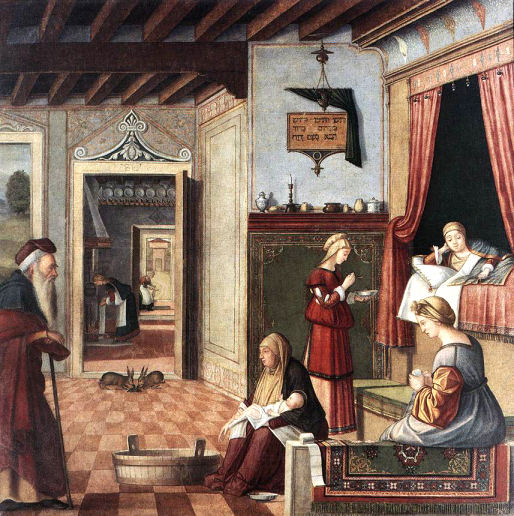
|
|
Calegheri |
History
The shoemakers' guild was founded in 1278
and initially met at the church of
Santa Maria della Carità where the body
of Saint Aniano (the patron saint of shoemakers) was venerated. In 1446
they bought this building and after building work they moved here in 1478.
They had a meeting room on the first floor and a hall at ground level.
After the Napoleonic suppression the building passed into private hands
and was long a furniture shop. At the end of the 20th century it was
bought by the municipality and is now a local library.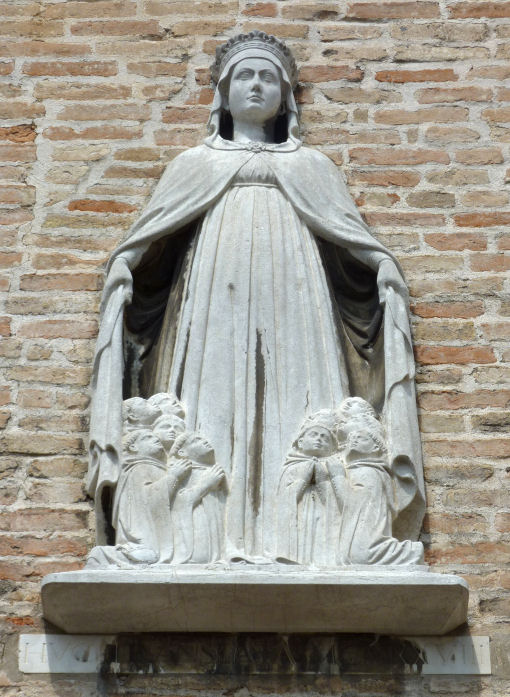
The building
The lunette over the doorway is a bas-relief upon which traces
of polychrome remain, showing Saint Mark Healing Saint Aniano from 1478 by Pietro Lombardo.
And there's a 14th century relief of the Madonna della Misericordia higher
up on the wall
over the door from the demolished church of
Santa Maria dei
Servi.
In the hall downstairs considerable traces of 15th century frescoes
remain, among which can be seen an Annunciation and some Saints.
|
|
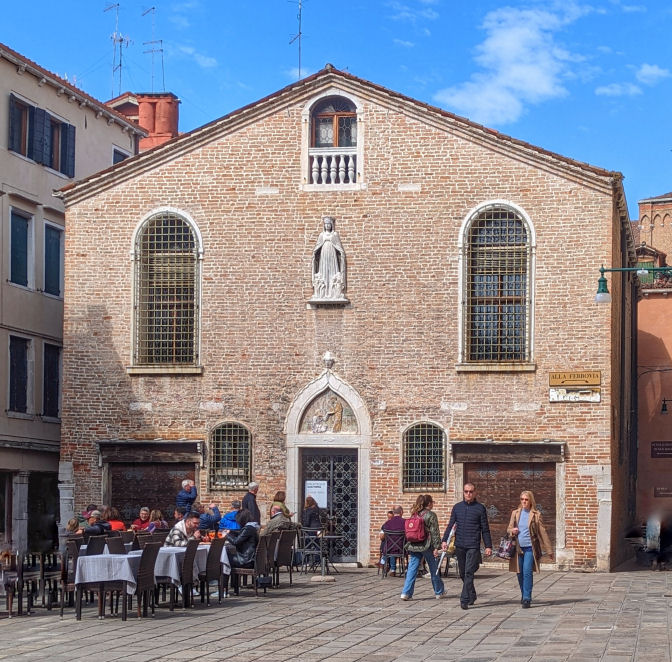
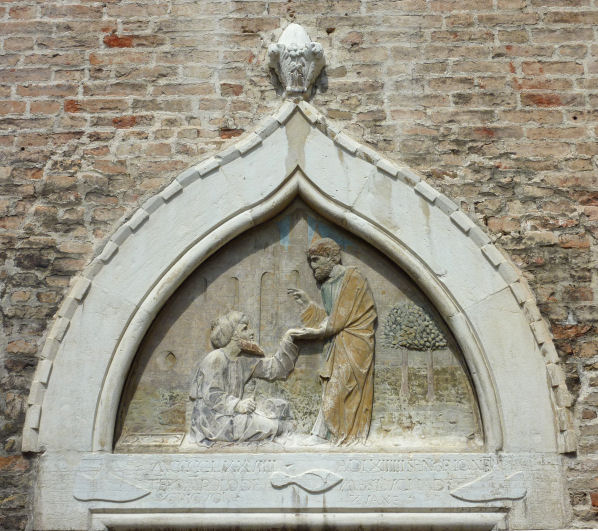
|
|
Laneri |
|
|
|

|
|
Mercanti |
History
The Scuola dei Marcanti (merchants) used the pink building to the left of the
Madonna dell'Orto, a church which was
originally dedicated to Saint Christopher. The confraternity moved here when it was
created in 1570 by the merging of the Scuola dei Santa Maria della
Misericordia e San
Francesco dei Mercanti e Naviganti, founded in 1261, and the Scuola di San Cristoforo
dei Mercanti,
with the former moving from its original home at the
Frari, where it had
been since 1349. The building they moved into here had dated to 1377, but
complete rebuilding began immediately, with land leased by the church to
extend the building to the rear.
Initially the architect (or at least surveyor) was Gian
Giacomo de' Grigi but later work was to designs by Palladio, and was
completed in 1573, with the scuola still arguing with him
over his fee. He won the suit in the same year, in which he had maintained that he was
responsible for the designs and also supervised the building work for
eleven months, but received a smaller fee than he'd sued for, but the
scuola had claimed the plans had been a gift. His work here is not mentioned much in the literature,
presumably because it doesn't involve a monumental temple façade or looming
columns, and the degree of his involvement is still argued.
The scuola was suppressed in 1806, but the building was restored
in 1876 and the Sala Superior became an oratory. The ground floor hall has
been used as a theatre, a cinema, and for jumble sales and exhibitions.
The 15th-century sculpted Madonna della Misericordia plaque over
the door to the campo (see photo below right) came from the Scuola di San Cristoforo's
original building over by the
Frari.
Lost art
The albergo decoration began first, within a few years of the
buildings completion, from 1576-1581, with paintings by Domenico
Tintoretto, Palma Giovane, Veronese and Benedetto Caliari, his younger brother, each providing
one panel for a wall each, with Domenico Tintoretto providing one for the
ceiling too, probably after the walls were filled.
This ceiling painting
was of the Coronation of the Virgin, and was surrounded by four
Evangelists and four Doctors of the Church by Aliense. This
panel completed the Marian cycle beginning with the oddly steep Birth
of the Virgin
and ending with the altarpiece of The Assumption, also by Domenico
Tintoretto, which featured portraits of the confraternity's officers.
(Jacopo and Domenico Tintoretto were both members of the confraternity.) All
of the art was seized by the state when the confraternity was
suppressed in 1806.
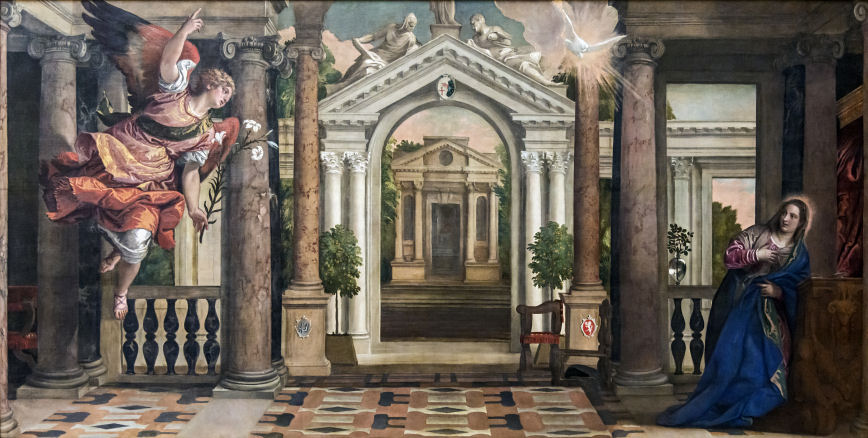
Two of the paintings ended up in the Accademia,
including that special Annunciation by Veronese of 1578 (see
above), which hung over
the door in the Sala dell’Albergo. The coat-of-arms of the Scuola is over the central arch of the
Palladian loggia, with the arms of the commissioning Cadrabazza and Cottoni families on
the bases of two flanking columns. The canvas has been cut down at the
top, as is evidenced by only the lower legs of the statue crowning the
arch remaining. It is thought to have been a personification of Faith.
Personifications of the Old and New Testaments lounge either side of
the tympanum.
Also the Nativity of the Virgin by Benedetto Caliari,
which probably also includes portraits, now on loan from the Accademia to
Palazzo Farsetti. The rest, including Tintoretto's Assumption
altarpiece the ceiling, have disappeared.
Domenico also provided the eight ceiling paintings
in the sala del capitolo upstairs, with arguable help from his father Jacopo,
of Old Testament episodes, with an altarpiece of The Nativity of the
Virgin, attributed to both of them, flanked by two group portraits of scuola members
by Domenico. These works
were all removed in 1806 too, the Nativity and flanking portraits
are in the Accademia but all but two of the ceiling paintings are lost.
The stanza terrena ceiling had eleven scenes of The Passion by
Domenico Tintoretto with four Evangelists in the corners. The
altarpiece in here was The Virgin and Child with Saint Christopher
by Jacopo Tintoretto. There were fourteen scenes from the life of Saint
Christopher on the walls by Domenico Tintoretto and a Lamentation by him
with help from Aliense. All of the paintings were lost, except the
altarpiece, which turned up in a parish church near Bergamo.
Two panels, each depicting 18 portraits of the Members
of the Scuola dei Mercanti by Domenico Tintoretto are also in the
Accademia, but not on display. They originally flanked the Nativity of
the Virgin attributed to Domenico's father Jacopo in the upper story
sala del capitolo.
|
|
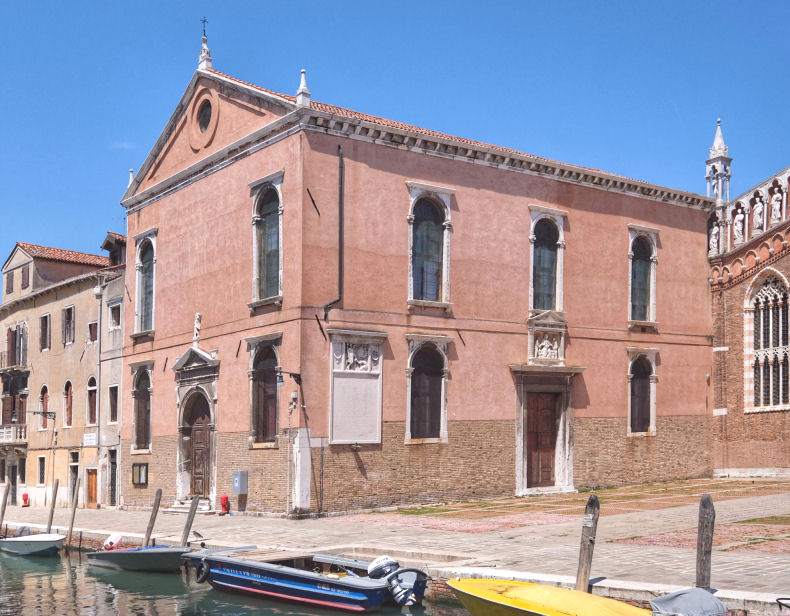

|
|

|
|
San Giorgio degli
Schiavoni
Scuola Dalmata delli
Santi Giorgio e Trifone |
History
Consecrated to two saints, George and Tryphon who were patrons of
Cattaro (now Kotor) in southern Dalmatia. Venice's ties with Dalmatia and Albania were strengthened when the region was
conquered by Venice in the early 15th century. On the 19th of May 1451 the
Council of Ten approved the setting up of this confraternity - schiavoni
meaning Slavs - which initially met near San Giovanni di Malta. In
1502 they acquired relics of Saint George, given by Paolo Valaresso,
commander of the Venetian fortresses at Modone and Corone, lost to the
Turks in 1500, who also commissioned Carpaccio's Saint George and the
Dragon and The Triumph of Saint George. The relics had been a
deathbed bequest to Valaresso from the Patriarch of Jerusalem. Around this
time work finished converting a
hospital building the scuola had bought from the Ospedale di Santa Caterina.
Carpaccio began work in 1502. From 1551 the scuola was
rebuilt by Giovanni De Zon, overseer at the Arsenale, during which work
the current façade was built. This work
involved bringing Carpaccio's paintings downstairs, by 1586, the building of altars
upstairs and downstairs, work on the façade and moving the staircase.
Upon suppression in 1806 the Grand Master
here wrote to Beauharnais, Napoleon's man on the spot, pleading a special case for "this last bulwark of the
Schiavoni" and was granted a rare exemption from art-looting.
The building
Over the entrance is a marble relief of Saint George and the
Dragon (1552) by Pietro da Salò, a pupil of Sansovino. In composition
it is not unlike Carpaccio's version inside the scuola. Above it is the earlier
Virgin and Child with Saint John the Baptist presenting a brother and Saint Catherine
(mid-14th century) from the old Ospedale di Santa Caterina building,
previously on this site. The outside wall down the right also
retains traces of the building before the 1551 rebuilding.
Interior
On the ground floor are the justly famous nine
panels painted for the Albergo
upstairs by Vittore Carpaccio
between 1502 and 1507 and dedicated to the lives of Christ, the original patron saints of the scuola,
George and Tryphon, and Saint Jerome, who was added to the dedication
later and was also a Dalmatian native. They are the only cycle painted for a scuola still
in situ and underwent conservation work in 2019-20.

Probably the most famous is Saint Augustine
in His Study (see above), with its warm evening light, striking still-life elements and attentive cute
white dog. It shows Augustine in his study writing a letter to Jerome, just
at the moment he is pondering in writing the question of whether martyr
saints like John the Baptist were more blessed, when the just-deceased
Jerome comes to him in a shining radiance and assures him that there is no
such distinction in Heaven. Augustine is said to have been painted as a
likeness of Cardinal Bessarion. The use of infrared reflectography has
shown that the little dog was originally an ermine. A drawing now in the
British Museum confirms this
On the
right wall are three well-known scenes of the life of Saint Jerome (Saint
Jerome and the Lion, The Funeral and the Vision of Saint Augustine) and two
smaller New
Testament scenes: The Agony in the Garden (from Matthew's gospel)
and The Calling of Saint Matthew both painted in 1502. On the left is the legend of Saint George in three scenes,
(the Killing the Dragon, the Triumph and the Baptism of the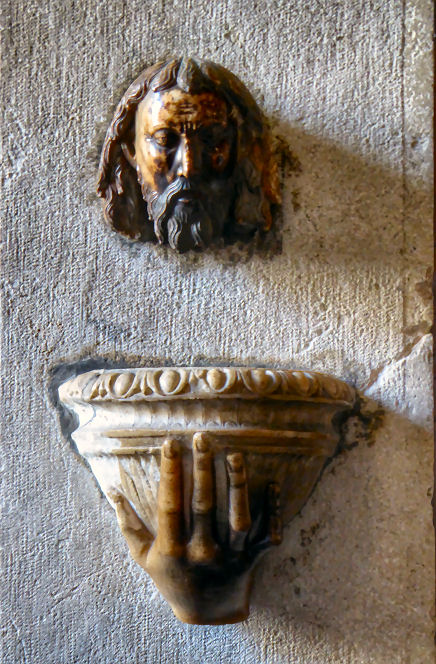 Pagans). Saint Tryphon Exorcising the Demon, features the
obscure saint (he's not in The Golden Legend), the patron of
Cattaro (present-day Kotor) a city under Venetian dominion at the time,
whose relics had been smuggled out of Asia Minor (present-day Turkey) by Venetians and taken to Cattaro in 809. The
Virgin and Child over the
altar, from c.1501-12, was said to be by Benedetto Carpaccio, Vittore's son. It had previously been
attributed to Vincenzo Catena, but now seems to be attributed to Vittore
and his workshop.
Pagans). Saint Tryphon Exorcising the Demon, features the
obscure saint (he's not in The Golden Legend), the patron of
Cattaro (present-day Kotor) a city under Venetian dominion at the time,
whose relics had been smuggled out of Asia Minor (present-day Turkey) by Venetians and taken to Cattaro in 809. The
Virgin and Child over the
altar, from c.1501-12, was said to be by Benedetto Carpaccio, Vittore's son. It had previously been
attributed to Vincenzo Catena, but now seems to be attributed to Vittore
and his workshop.
The door to the right of the altar leads to the sacristy, which had been
used by the Scuola di San Giovanni, but following that scuola's
suppression it was incorporated into the Scuola Dalmata in 1839. It now
contains the scuola's 'important objects' - silverwork and such.
To the left of the altar the staircase begins with a sweet holy water
stoup held by a female hand (see right) above which is a head of St John the Baptist,
an English alabaster of the 16th century
Even the Scuola's own
guide speaks of the works upstairs, mostly from the 17th century, as 'of little artistic
interest'. The upper hall (the Albergo) (see photo below right) has
a wooden ceiling worked by Zuane de Bastian in 1604, with painted panels
attributed to Andrea Vicentino. The central octagon shows The
Apotheosis of Saint Tryphonius, with irregular triangles of the
Evangelists and ovals of God the Father, The Virgin and Child
and Saints Jerome and Barbara(?). The carved wooden altarpiece is quite interesting. It
was probably the ceiling roundel up here when the Carpaccios where on the
walls. It's flanked
by a pair of panels, depicting Saints Jerome and Tryphonius described as 'influence
of Antonio Vivarini'.
Ruskin wrote
Of the figures of the princess and her father in the
second St George scene: 'there is nothing elsewhere in art that
is the like of this little piece of work for supreme, serene, unassuming,
unfaltering sweetness of painter’s perfect art'.
And on a Christmas
visit after the death of his beloved Rose la Touch he came over all mystical and
hallucinated that she was communicating with him via symbolic plants and
parrots in the Carpaccio paintings.
Of the warm palette of the Carpaccio cycle he said 'having the
effect ... of a soft evening sunshine on the walls, or glow from embers on
some peaceful hearth'.
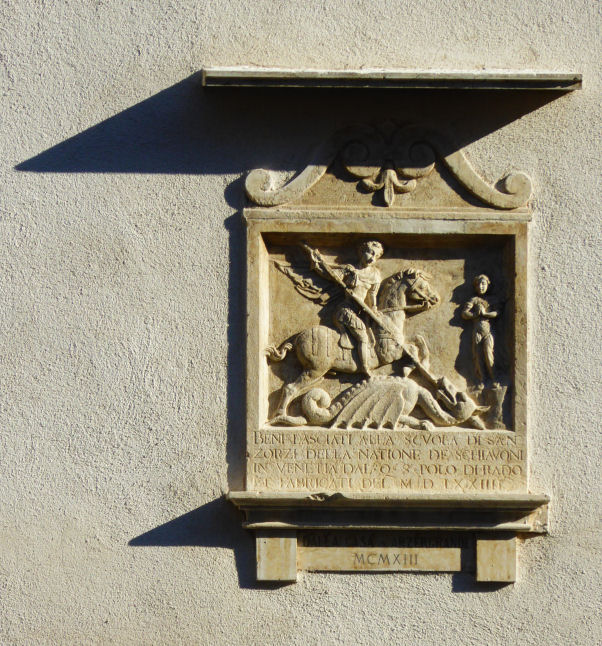
Henry James wrote
The place is small and incommodious, the pictures are out of sight
and ill-lighted, the custodian is rapacious, the visitors are mutually
intolerable, but the shabby little chapel is a palace of art'
Opening times
Daily 10.30-2.30
map
|
|
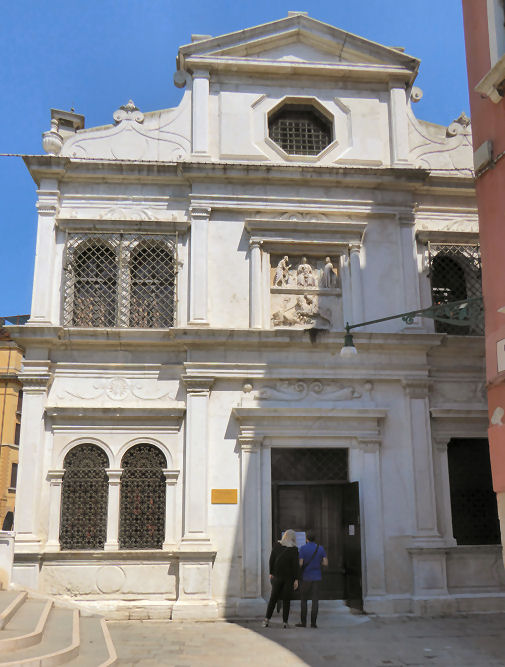
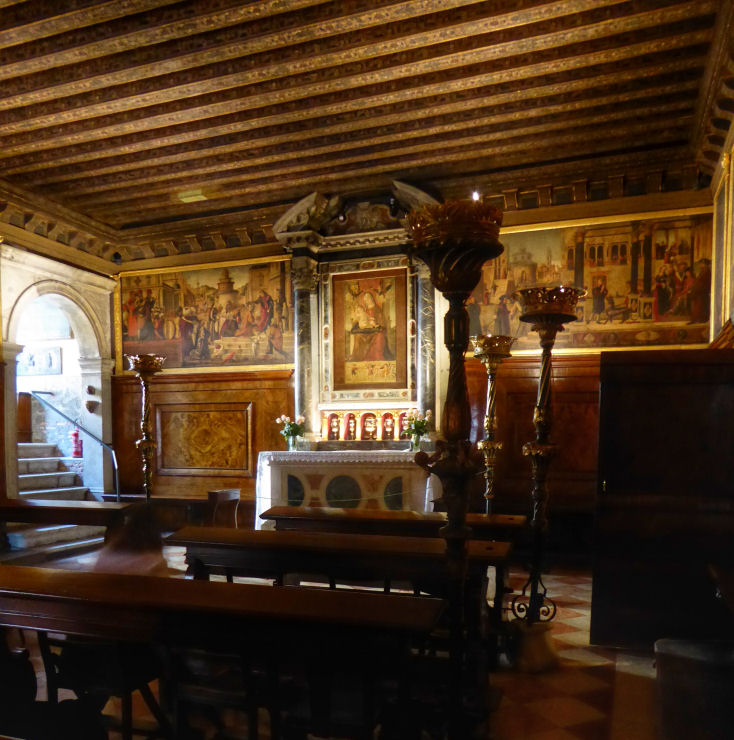

 |
|
San Fantin
|
History
This scuola came about when the Scuola di San Girolamo and the
Scuola di Santa Maria della Giustizia merged. Members accompanied and comforted condemned criminals on
their way to their place of
execution, so they were also known as the Scuola dei Picai (of the hanged men,
also ...degli Impiccati).
They originally met in the nearby church of
San Fantin. This new building was
begun in 1580 following fire damage to its predecessor in 1563. Lorenzetti says it was designed by
Antonio Contin with help from Alessandro Vittoria, but the latter is the
name most mentioned. The pediment was topped
in 1584 with statues of the Virgin Mary and Two Angels by Andrea dell'Aquila and
Agostino Rubini, pupils of Vittoria. The relief of the Crucifixion is by
Andrea dell'Aquila.
The albergo, on the
first floor had its ceiling painted around 1582 with an Assumption by
Palma Giovane, now lost (see below). Palma also painted panels for the
ceiling of the Sala Terrena on the ground floor. These featured various
Biblical scenes relating to the Scuola's duties with regard to comforting
the condemned and their means of expiation. Around 1664 the albergo
piccolo was added and the new sacristy on the ground floor.
In 1806 the Scuola was abolished
by Napoleon, the oratory's altars were removed and the building became
home to Società Veneta di Medicina. It now houses
The Ateneo Veneto di Scienze,
Lettere ed Arti, an institution created by merging this medical
society with two others. It's dedicated to science, literature, art and
culture, with the aim of promoting social solidarity, we are told. The
oratory on the ground-floor is now their conference hall. The albergo on the
first floor is now a reading-room, the albergo piccolo is now the Sala Tommaseo
and the new sacristy is now a meeting-room. The art here includes works by
Tintoretto, (studio of) Veronese, Palma il Giovane, Antonio Zanchi, Francesco Fontebasso, Pietro Longhi and
Alessandro Vittoria.
The Apparition of the Virgin to Saint Jerome was painted by
Tintoretto c.1580 for the altar in the Albergo Grande here. It went to the
Accademia in 1913 but in 1973 was returned here to the Ateneo's reading
room. It was cleaned and conserved in 2018.Lost art
The Assumption of the Virgin, in the ceiling of the albergo by Palma
Giovane, was damaged in 1740 by a lightning strike to the roof, at the
turn of the century by rain water and then by the ceiling's collapse in
1825. It was removed and cut into pieces, which went into storage and
continued to be seen until 1837, after which all trace disappeared, until
a fragment showing The Apostles at the Tomb was purchased in Venice
by a Russian collector, who gave it to the Hermtage in 1915, where it
remains. A fragment from it depicting Adam and Eve was said to be in a
private collection in Paris in the 1960s. By the same artist, a Saint
Jerome in his Study and (reportedly) an Apparition to Saint
Augustine, now in the church of
San Girolamo.
Opening times
For exhibitions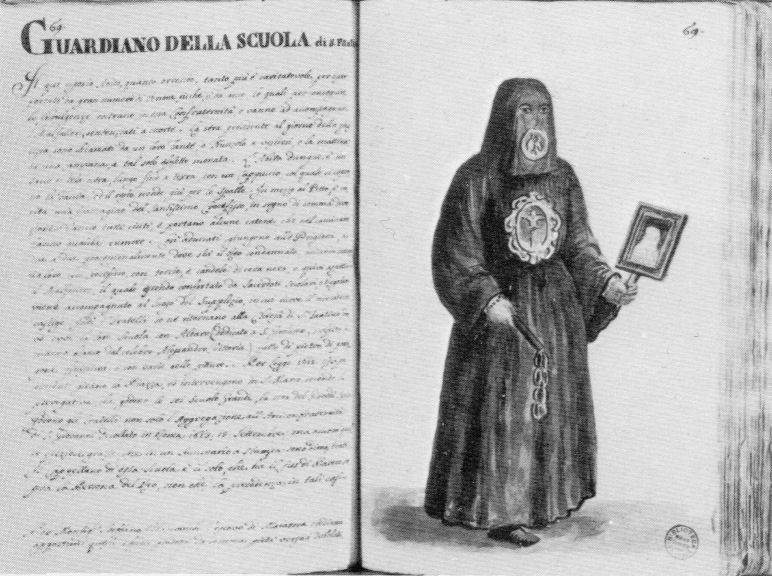
Vaporetto Santa Maria del Giglio
map
Guardiano della Scuola di San Fantin by
Giovanni Grevembroch
|
|


|
|
Santissimo
Crocifisso |
History
The Confraternity (also known as the Scuola de
la Bona Morte) was established in 1635, initially building and using a
small chapel (now lost) under the portego of the church of San Marcuola.
In 1643 the surviving seat of the scuola was built. Its interior had
paintings from the 17th and 18th centuries which have been restored and
kept elsewhere and will, we are told, be brought back here as soon as
possible. |
|
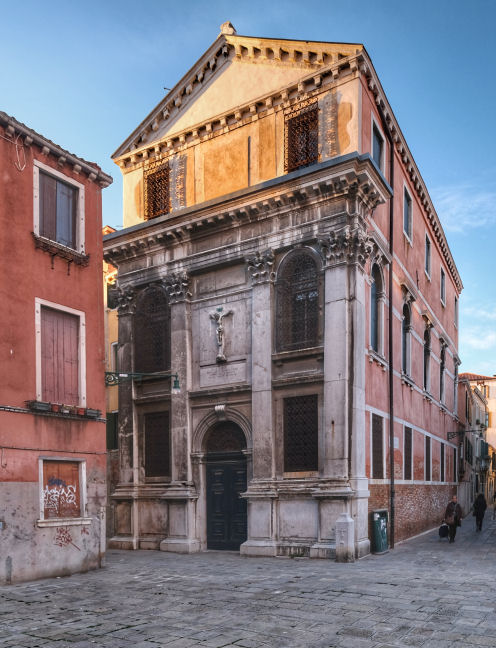
|
|
Varoteri |
History
Unusual for being so
free-standing and isolated, this was the hall of the guild of
furriers, founded by 1271 and celebrating their feast day in the church of
the Crociferi, now the
Gesuiti church
by 1446. In 1501 the scuola was given permission to build an albergo
there, which protruded to the left of the church's façade. When the
Jesuits returned to Venice in 1657 they bought the whole Crociferi complex
and their rebuilding resulted in the demolition of the hall to make way
for the new church's projecting façade. In 1723 the senate gave the
Varoteri permission to rebuild, in Campo Santa Margherita. The Jesuits
magnanimously compensated the scuola 1900 ducats and returned their
fixtures and fittings in 1724. The scuola moved in here in 1725. In 1808,
at suppression, the Varoteri possessed an altarpiece and thirteen
paintings, two of which were said to be "valuable".
Post-suppression it has been a store for firewood, a
cinema (1910-15), and a school of fascist propaganda and
headquarters.
A plaque on the wall gives the minimum sizes for the fish that have
long been sold nearby, the sale of too-small fish being prohibited.
The building
On the north side upper floor is
a very worn marble relief of the Madonna della Misericordia from
1501, which was previously attached to the old guild building near the
Crociferi. The south side used to face onto the Rio della Scoazzera,
filled-in in the 19th century.
Lost art
According to Boschini the scuola had the Resurrection of Lazarus by
Carletto Caliari, the youngest son of Paolo Veronese, (see below)
now in the Accademia, and Christ Freeing the Paralytic Man by
Baroque artist Pietro Liberi.
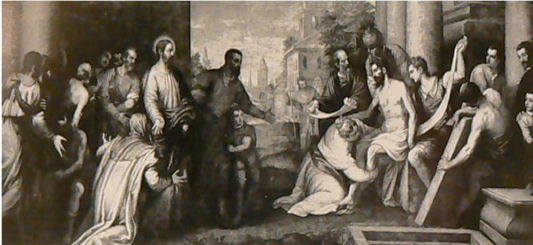
|
|
 |

|
|
San
Francesco |
|
San
Girolamo |
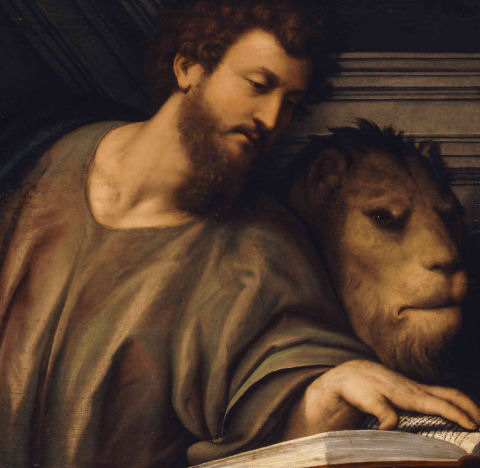
History
The scuola's 15th-century
building was at the west end of the Campo dei Frari. It was converted to
housing after the scuola's suppression at the end of the 18th century.
Lost art
The scuola had ceiling paintings in the small Stanza Terrena by Pordenone
featuring The Stigmatization of Saint Francis and surrounding
square panels of busts of the Evangelists and octagonal ones of Franciscan
saints. They were taken down in the early 18th century. The central panel
was lost, the Four Evangelists (that's Saint Mark left) and
two of the Saints (Anthony of Padua and Bernardino of Siena)
went to Budapest, with the other two saints (Bonaventura and
Louis of Toulouse) now in the National Gallery in London. |
|

History
The oratory of the Scuola was behind the church of
San Girolamo. Founded in the 14th century its decoration dated to the
15th. Following some mid-18th-century restoration the Oratory was
suppressed and closed in 1810-14, also suffered looting by a mob in 1884.
Lost art
A Communion of Saint Jerome by Lazzaro Bastiani from here is in the
Accadamia, which also has a Funeral of Saint Jerome by the
same artist looking like it's from the same series.
Part of the late-15th-century decoration was a ceiling roundel of God
the Father Blessing by Alvise Vivarini, now in the Accademia. It was
still in the scuola in 1843, was removed and passed into private hands, and
was bought
by the Accademia in 1899. It is now in the centre of the spectacular
carved ceiling of Room 1 (see photo right).
|
|
Sant'Orsola |
 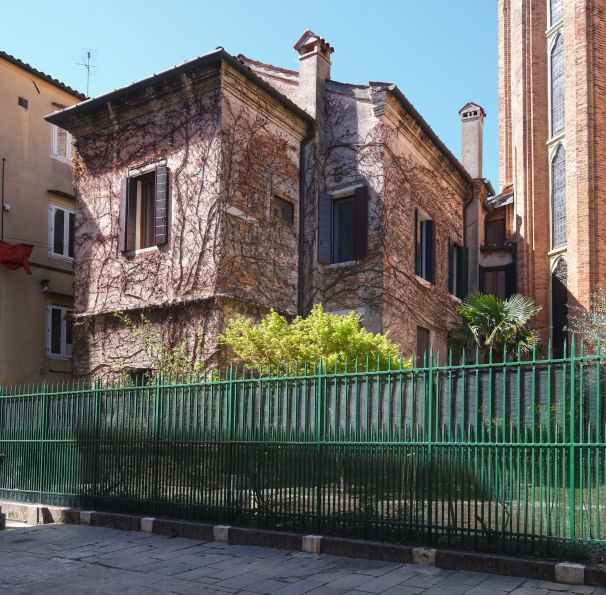
History
The Scuola di Sant'Orsola was founded on 15th July 1300, probably on the
initiative of friars from Santi Giovanni e Paolo. In 1306 a meeting house
and chapel was
built, on the cemetery of the convent, which remains, to the right of the
south transept, although hidden (see
old photo left showing the 1504 extension of the presbytery - the
east-end chapels of Santi Giovanni e Paolo are behind it to the right).
The Scuola was suppressed by Napoleon in 1806.
Lost art
This scuola is now most
remembered for its commissioning of the Saint Ursula
cycle from Carpaccio, which is now in the Accademia. An ambitious program
for a scuola piccola, a
meeting of 16th November 1488 decided to finance the decoration of the scuola's
ground floor chapel and meeting-house and the young Vittore Carpaccio
was employed. The scuole piccolo became his major clients. The cycle of nine paintings was Carpaccio's first and
largest cycle. The first canvas, The Arrival in Cologne, was
finished in 1490 - it was his first dated painting. The remaining seven and the altarpiece
here were completed by 1500.
They shared the chapel with the scuola's venerated relic of the saint's
head. Unusually more than ten sheets of drawings remain of preparatory
drawings for this cycle. When the Scuola was suppressed by Napoleon in 1806 the paintings were removed
on October 10th 1808 and put on display in the Accademia in 1828.
Ruskin wrote
Of The Dream of St Ursula from the cycle he wrote 'There
she lies, so real, that when the room's quite quiet, I get afraid of
waking her!' In his later life, in times of he would associate the
paintings of the life of St Ursula with Rose La Touche, the young woman
with whom he became obsessed before her early death. |
Scuola dei Mureri (masons)
Where the Salizzada di San Samuele
splits into Salizzada Malipiero and the Calle delle Carozze.
Lost art
Their altarpiece was the Incredulity of
Saints Thomas and Magnus (patrons of the scuola) of 1504/5 by Cima da
Conegliano is now in the Accademia, where it's been since 1829.
Santa Maria Maggiore
Was next to the convent of the same
name.
Lost art
Possessed the early Palma Vecchio Assumption
of
c.1513 now in the Accademia
|
|
Santissima Trinità
The original building was demolished in 1642 to make way for the Salute.
The paintings below were then relocated.
Lost art
The scuola's sala dell'albergo had five scenes from
Genesis, in a program begun in 1547, with four by Francesco Torbido. A
document of 1553 states that two more were needed for the sides of the
altar. After which date Tintoretto provided five canvases of scenes from
Genesis, four of which
survive. Cain Killing Abel, The Temptation of Adam and Eve
and the odder and more famous Creation of the Animals
are in the Accademia. A fragmentary Adam and Eve Before God
the Father is in the Uffizi and the Creation of Eve is lost.
|
|
Santo Stefano |
|
History
There's a small 15th-century lunette relief of Saint
Stephen, venerated by men (on the left) and women (on the right) on a building
opposite the church of Santo Stefano, now a pharmacy with housing above,
which once belonged to the Scuola di Santo Stefano.
The scuola was founded
on March 3rd, 1298, making it one of the oldest. Saint Stephen was the
earliest Christian martyr, having died at the hands of non-believers and
being the only martyr recorded in the Bible. His relics came to San
Giorgio Maggiore in 1110. The
majority of the members of the scuola were stonecutters, whose patron saint was Stephen as he
was martyred by stoning (called lapidation).
For meetings and services they
initially used their altar and the sacristy in the church of Santo Stefano. In 1437 they bought land opposite the
church's façade (occupied then by the monk's cemetery) from the Augustinian friars and built a meeting hall,
which was enlarged in 1473 with the addition of a chapel, and from 1476-93
with an upper floor.
Lost art
The membership
grew and in 1506 Carpaccio was commissioned to paint five scenes from
the life of the saint for the Sala dell'Albergo on the first floor, from 1511-20,
his last such cycle. One canvas, The Trial, was lost during the
Napoleonic suppressions (although a drawing of it is in
the Uffizi), while the other four are now in the Louvre, the Brera,
Stuttgart and Berlin. These are the Ordination, Preaching in Jerusalem,
Disputation, and Martyrdom. The Ordination (see right) shows
Stephen receiving the blessing of Saint Peter outside Jerusalem on the
right. The left hand side is dominated by headwear.
The altarpiece, now also in the Brera, was a
triptych of c.1510 by Franceso Bissolo depicting a full-length Saint
Stephen in the centre flanked by panels of Saints Augustine and Nicholas
of Tolentino.
With the Napoleonic suppressions of 1806 the furnishings and
decorations were dispersed.
|
|

 |














